LEGACY





Three of our ranch management team open up about the regenerative practices they’re investing in on their home ranches.
Grassland restoration and the production of top-quality Montana-branded beef co-exist at Little Belt Cattle Company.
Going from a bermudagrass monoculture to more diverse native species isn't always pretty to watch.
A look at the future of firefighting and ranching in Texas after its largest wildfire.
There are two ways to increase ranch profitability: increase your revenue or decrease costs. Applying regenerative ranching practices to your land and business can do both.



Harness the power in your soil for better forage, better livestock and better returns.
Use your available forages to get the best out of your livestock and grazing land. Equip yourself with the knowledge to convert your grazing decisions into profit.

SEEING IS BELIEVING
Three of Noble's ranch manager team members discuss the regenerative practices in use on their home ranches.
MONTANA’S LITTLE BELT CATTLE COMPANY is proof that regenerative ranching works.

IN TEXAS, FORAGE IS FOOD AND FUEL
At age 90, former bank president and rancher Henry Weinzapf generously supports Noble's regenerative mission. 24 32 36 42
Transitioning ranchland from a bermudagrass monoculture to more diverse native species means embracing the messiness that comes with change.
Experts and ranchers weigh in on the future of firefighting and ranching in Texas after the state's largest wildfire.
INVESTING IN THE NEXT GENERATION OF RANCHERS
1 2 1 6
Read about Noble's research into prioritizing soil health in pecan orchards, which includes tracking dung beetles and other signs of soil life. Also see the goats that clean up brush on Oswalt Ranch.
Noble’s new regenerative ranching course schedule, plus a variety of innovative articles, videos, podcasts and social media accounts to explore.
Deborah Clark of Birdwell & Clark Ranch in Texas is featured in this new partnership series with Drovers magazine..


Tempt your family with a tasty, tender marinated steak dish, and pick up tips for fencing water gaps from Noble's Devlon Ford. Hard Work and Horse Sense: A love of ranching and rodeo comes together for Paul Luna in his job as a Noble ranch facility manager.


Noble
STEVE RHINES PRESIDENT/CEO
RACHAEL DAVIS EDITOR
CADIE RAMOS GRAPHIC DESIGNER
ROB MATTSON PHOTOGRAPHER
MADDY BEZNER
LAURA BRENNER WRITERS
MARILYN CUMMINS WRITER/COPY EDITOR
AMIE STEARNS
WEB DESIGNER
CONTRIBUTING WRITER
Burt Rutherford
Noble Research Institute is the nation’s largest nonprofit agricultural research organization, serving farmers and ranchers with research, education and mentorship for regenerating soil health to improve their land, livestock and livelihood. Since 1945, Noble Research Institute has been a leading, trusted resource in agricultural research and education dedicated to land stewardship. Demonstrating our ongoing commitment to regenerating our nation’s grazing lands, Noble actively manages 13,500 acres of working ranchlands to provide real-world insights and applications for farmers and ranchers. To learn more about Noble Research Institute, visit www.noble.org.
Reprint requests may be made by contacting Rachael Davis, editor, by email at rwdavis@ noble.org
Legacy is provided at no cost to the general public as a courtesy of Noble Research Institute. To receive a copy of the magazine or to change your mailing address, please email tlcumbie@ noble.org
Noble Research Institute, LLC 2510 Sam Noble Parkway Ardmore, Oklahoma 73401 580-223-5810
ISSN: 1939-5035
When we announced in February 2021 that Noble Research Institute was taking a direction toward regenerative agriculture, I knew it would raise many questions — and eyebrows. How do soil health principles benefit ranchers? Even as we stayed true to Lloyd Noble’s vision for thriving agricultural communities through better soil health, it became our task to demonstrate the value of this decision to ranchers and farmers.
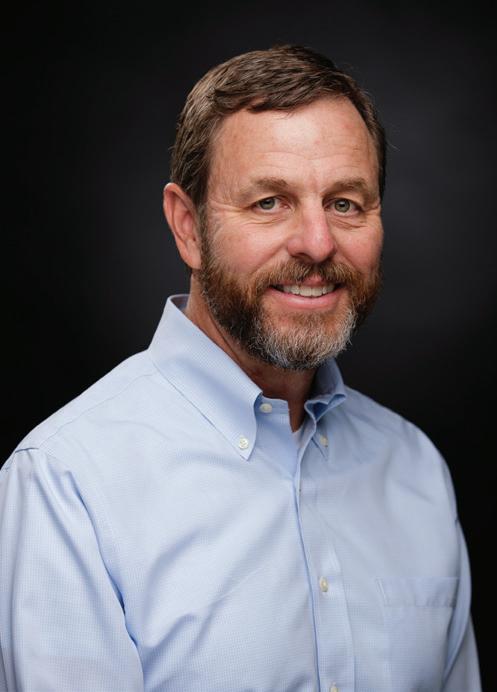
This demonstration begins on our own ranches. Our 2021 decision directly impacts our ranch management. Similar to the daily decision-making of ranch managers across this country, our management philosophy drives both big and small decisions daily. This helps us see today’s opportunities and plan for tomorrow’s challenges facing these important working lands.
Our focus changed, but our mission to support America’s ranchers, farmers and agricultural communities did not. We are working toward an ambitious goal of farmers and ranchers regenerating 164 million acres of grazing land by 2040. It’s a goal that will create more resilience and profitability in their operations and at the same time protect and restore our nation’s grazing lands and grasslands.
Beyond grazing production, we’re investing in research across our ranches and beyond to help answer both ecological and economic questions. Our research team studying the transition of our ranches from conventional management to regenerative is beginning to see trendlines for soil health, water-holding capacity and macroinvertebrate activity. We’re only a couple of years into the data, so we can’t yet draw any final conclusions, but it’s exciting progress toward establishing science-based data we and others can use.
In the last year, we returned to our roots—delivering producer-directed educational programming. Since our first class in July 2023, we’ve worked with more than 270 individuals, impacting 280,000 acres of ranchland across seven states. The feedback from attendees has been incredible.
A rancher from Tennessee sent us an email after returning home from his Noble course. He wrote, “That was the best workshop I’ve attended in my seven decades.” We appreciate his sentiment, and we strive to achieve this level of satisfaction for all our course participants.
We are working to expand our course locations to much of the Great Plains and other key livestock-producing states. Through our in-person and future on-line educational paths, we share knowledge, skills and confidence to impact livestock production, profitability and land stewardship. Our work helps livestock producers balance three key elements of every livestock operation: money, grass and livestock.
I look forward to you learning more about members of Noble’s invaluable ranch management team — the subject of this issue’s cover story. We see that for them, managing the land for improved soil health is not just an 8-to-5 job for Noble. Rather, they each have applied these principles at home.
Noble is a special place with a great purpose, an excellent history and a superb collection of like-minded individuals who seek to serve the ranchers, farmers and landowners of this nation. Thank you for learning more about our story, the great people who define our organization and its activities, and the people we work with along the way who are making a difference. Enjoy.
Every acre matters.

Steve Rhines, president

BY MARILYN CUMMINS
WHAT HAPPENS WHEN you make soil health the top priority for pecan orchards? Noble’s pecan strategy research team is looking for answers in a comprehensive sixyear study, and the two silvopasture orchards on Noble Ranches play an important role.
Prior to the spring of 2021, the 25-acre pecan orchard of Noble’s Conrad-McMillan Pecan Farm was managed like many conventional orchards. Ranch facility manager David Miller used herbicides to control grass and weeds in 6-foot strips on both sides of the tree rows and sprayed fungicides and insecticides up to eight times a year to protect the six types of improved pecan cultivars growing there. The orchard was not grazed.
At the Noble Red River Ranch, ranch facility manager Kevin Pierce managed the 300 acres of native and older improved pecan cultivars somewhat less intensively, but did mow and spray herbicides at times, especially to try to control the honeyvine milkweed that would wrap around equipment at harvest. He also sprayed for fungal diseases and harmful insects, more so in the non-native groves. Cows and stocker cattle were let in to graze, especially for the 90 days of good grazing on cool-season annuals March through May.
This spring marked three years since the start of the Noble Ranches’ overall transition to regenerative ranching, with faith in the belief that using silvopasture while focusing on soil health will be good for the soils, the livestock, nut production and even producer well-being. They “went cold turkey” in the pecan orchards, Miller says, ceasing all chemical and synthetic fertilizer applications, although he still irrigates when needed.
Today, both managers describe orchards full of more plant, insect and animal diversity now that they’ve stopped spraying. (See sidebar p. 8) They use adaptive multi-paddock grazing to rotate cows, calves and stockers as well as sheep and goats to feed on the plentiful forage (including the honeyvine) and benefit from the shade. This is the practice of silvopasture — a regenerative system that deliberately integrates livestock and trees, with benefits to both enterprises and especially to soil health.

The pecan strategy research team at Noble has set out to monitor and collect data across a continuum of management practices in producer pecan orchards and on Noble Ranches.
Many commercial pecan producers, however, are highly data-driven as they strive to boost nut production and profits, says Nikki Charlton, Noble Research Institute systems research manager and co-principal investigator for a major Noble pecan strategy research project now underway. Such growers understandably need to see numbers and successful examples to feel confident about changing how they’ve managed their orchards for years.
That’s where the combination of Noble Ranches and Noble researchers
comes in. The pecan strategy research team at Noble, led by Charlton and co-principal investigator Lauren Jones, Noble senior research associate, has set out to monitor and collect data across a continuum of management practices in producer pecan orchards and on Noble Ranches. Those practices range from high-input, fully conventional orchard management, to those in transition to more regenerative practices, all the way to the Noble orchards, where the primary focus is soil health, using silvopasture and no chemical inputs.


“Our hypothesis is when you apply more soil health principles, soil health should improve, leading to healthier trees and healthier nuts,” Jones says. She and the team hope, over time, to be able to put numbers to how different management practices impact soil health, nut nutrient value and producer profitability.
In 2022, Noble began monitoring soil health changes at 67 sites established in the orchards at both the Conrad-McMillan Pecan Farm and at Red River Ranch. The on-ranch monitoring was a precursor to Noble launching its six-year-long “Pecan Strategy Research” monitoring project in 2023, as of this writing collaborating with 22 pecan producers representing 2,200 acres of pecans across Texas and Oklahoma, two of the top five pecan-producing states.
As it monitors 151 sampling sites (producer and Noble), the Noble research team is:
• Collecting soil samples for soil health and microbial community structure testing.
• Collecting leaf samples for tree nutritional status.
• Developing nutrient assays to measure nut nutrient density and phytochemical composition from nut samples.
• Using scorecards to assess orchard health, including disease and insect reports.
• Preparing to do economic analysis that will compare profitability across the different management styles expressed as profit per acre.
• Working with an Oklahoma State University pathologist to monitor soil and nut samples for foodborne pathogens in order to inform producers regarding grazing regulations under the Food Safety Modernization Act.
• Defining lab protocols to identify bat species as well as the pecan pests they eat, using DNA extracted from bat guano. (The hope is that attracting bats to orchards can be a natural way to reduce pest damage of pecans.)
The project got a boost this year with the receipt of a $295,000 grant from the Greenacres Foundation that will

help support the research focused on improving soil health using agro-ecological principles while improving the resiliency of agricultural lands. The team also has a grant for the project from the Oklahoma Department of Agriculture, Food and Forestry.
Noble is in a unique position to both study and demonstrate what happens when you partner fully with nature in silvopasture pecan orchards.
“Regenerative agriculture is about trying to reduce inputs and work with nature,” Charlton says. “All of the decisions you’re making can really impact the system as a whole.”
Currently, the producer orchards in the study are managed along a continuum of practices, from fully conventional to soil-centric management. The study is documenting all those practices and the outcomes to track the differences. At Noble, the management of the Conrad-McMillan and Red River ranches is based on soil health versus maximizing pecan production as the top priority, hence the choice to eliminate inputs.
Being able to capture data from inputfree management at Noble is important, because “most producers might not be willing to make the decision to completely eliminate everything,” Jones says. The Noble pecan strategy study is a way to look at the results over time and provide that information to producers to help them in their management decisions.
The research team holds an annual pecan producer workshop to share research updates with participants and foster peer-to-peer networking. At the 2024 workshop in Ardmore, tours of the Noble orchards gave producers interested in incorporating livestock in their orchards the opportunity to see the fencing infrastructure in an orchard with irrigation.
“ Regenerative agriculture is about trying to reduce inputs and work with nature. All of the decisions you’re making can really impact the system as a whole.”
—NIKKI CHARLTON
In the Conrad-McMillan orchard, Ruby the guardian donkey watches over her flock of hair-sheep ewes and lambs as they graze in small paddocks in the orchard. Charlton recalls how excited the producers were to see how Noble uses temporary fencing to graze the orchard successfully without harming the irrigation system, a major concern for some of them.
Jones says pecan growers who before the workshop may have thought grazing “sounded like a ton of work, or thought ‘I don’t know anything about it; I just can’t do it,’” now may see grazing their orchards as a possibility after hearing how peers do it as part of their day-to-day routine and viewing Miller’s success in person.
While Noble has worked with pecans and pecan producers for many years, its past research and related consulting were focused on the nuts and bolts of conventional pecan production and economics. Now, with soil health as the focus, both the research and producer interaction have shifted to a more holistic approach.
“ We’re hoping to see if you manage with a focus on soil health, you will see improvement in soil health and higher profitability.”
—LAUREN JONES
“We’re hoping to see if you manage with a focus on soil health, you will see improvement in soil health and higher profitability,” Jones says. Along the way, the pecan strategy team is already supplying producer participants with tools like the orchard health scorecard to track their own progress while Noble conducts (and pays for) the sampling and analysis in their orchards over the six years of the study.
The team already sees some of the participating producers making changes toward more regenerative practices, Charlton says, “and I think seeing the results from this study will help them feel confident in incorporating the soil health principles in their management decisions.
“The growers are vested in this. They want us to be successful, not just for themselves, but for the pecan industry as a whole,” she says. “And we couldn’t do this without them. We’re learning from them as well.”
Plus, Jones says, “it’s a really exciting study, and the fact that we get to work and engage with producers makes it a lot more fun.”

RANCH
CLOVER AND VETCH. Spiders and wheel bugs, Butterflies, moths and bees. More deer, wild turkeys, bald eagles. And fewer wild hogs.
Those are just a few of the changes noticed by the managers of Noble’s pecan orchards now that they’ve stopped spraying chemical inputs and have been using multi-species grazing among the trees.
“I’m seeing a lot of spiders and wheel or assassin bugs,” says David Miller, ranch facility manager at Conrad-McMillan Pecan Farm, beneficials that can help control pecan insect pests.
At the Red River Ranch, manager Kevin Pierce notes more butterflies, moths and bees: “In the morning when you get out there and it’s still, there’s stuff flying everywhere. There are all different flowering plants for them to feed on. So not only are we not killing them (beneficial insects), but we’re not killing the plants that they’re feeding on, either.”
Note: That pesky honeyvine Pierce used to spray also is a native host for monarch butterflies.
Where he once sprayed herbicides, Miller now says “I had a huge abundance of clover this year, I mean as thick as I’ve ever seen it, and I’ve never planted it.” Red clover and vetch came on first and went to seed, then white clover came in. He plans his grazing strategically in the spring, he says, “because I want all those cool-season plants to go to seed as much as I can.”
Pierce sees more wildlife living in the bottomland orchards now that wasn’t there before “because we either kept it sprayed or mowed, and there was no cover for them. Now they have a place to live.” Miller used to see only an occasional turkey, but this year he has a whole flock in the orchard, with the first toms he’s seen there — “two big ones chasing the hens around.”
One thing Pierce is glad to see less of is wild hogs, thanks to the two guardian dogs that protect the sheep and goats as they graze the orchard.
“Wherever the dogs are, the hogs are not out there tearing up the orchard,” he says. “That’s helped with our wild hog problem, because the dogs don’t want them around.”
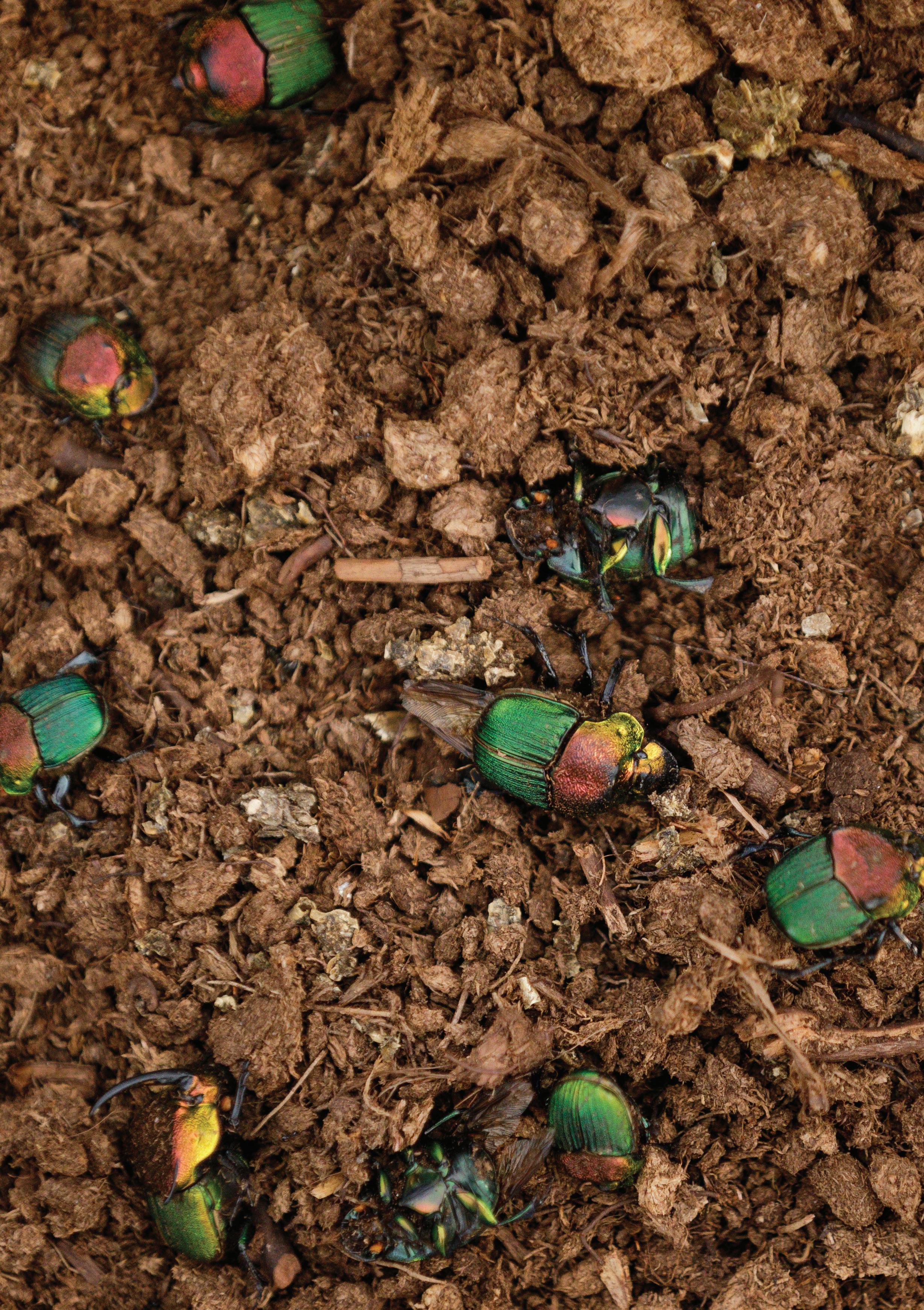
NOBLE RANCHES | COFFEY RANCH
DESIRABLE DUNG BEETLES are collected, sorted and counted as part of ongoing ecosystem research on Noble Ranches in collaboration with Oklahoma State University. These were in an overnight trap on Coffey Ranch in June. Multiple species of the beneficial beetles work together to break down manure quickly, helping add organic matter to soils while reducing parasite and fly populations.

NOBLE RANCHES | OSWALT RANCH
ON A SUNNY FRIDAY, more than a thousand goats are up with the sun on Noble’s Oswalt Ranch at Ardmore, Oklahoma. They’re awaiting their daily move to graze pastures after the cattle have moved on to their next fresh paddock. Noble leases the land to the goats’ owner for grazing, and the goats help the land by foraging on brush and depositing their nutrient-rich manure pellets throughout the pasture.

HEALTHIER SOIL & HAPPIER HORSES
HORSE PASTURES don’t have to be overgrazed, ‘sacrificial’ parcels of land, says Joe Pokay, general ranch manager at Noble. “Every acre matters,” he says. “If I apply the same principles to the 25 acres my horses graze as I do to the rest of the ranch, it’ll benefit from the same positive effects: fresh grass, better nutrition, better health for the animals, better health for the soil.”
READ MORE HERE: bit.ly/regen-horses

G BAR C RANCH
MEREDITH ELLIS and the Ellis family of G Bar C Ranch in Rosston, Texas, have won the 2023 National Environmental Stewardship Award from the National Cattlemen’s Beef Association. The annual award recognizes the outstanding stewardship practices and conservation achievements of cattle producers. G Bar C Ranch continues to improve ranching practices in ways that nurture the environment while remaining economically sustainable. The Ellises see themselves as caretakers of the land, maintaining biodiversity, natural habitat and clean waterways.
READ MORE HERE: bit.ly/ranch-award

JOSH GASKAMP likes to track grazing paddocks and management moves in Google Earth as a selfguided journey to good regenerative grazing. The Noble regenerative ranching advisor and manager says “when you start to journal your grazing on a map, it turns that map into a decision-making tool.” Read more about how he uses digital maps to journal his decisions and observations: bit.ly/dig-map-app

Recognizing the personality differences among their cattle could help ranchers select herds that best meet grazing needs on rangelands, leading to better animal health and environmental conditions, according to a new paper from the University of California, Davis, published in the journal Applied Animal Behaviour Science.
READ MORE HERE: bit.ly/match-cows
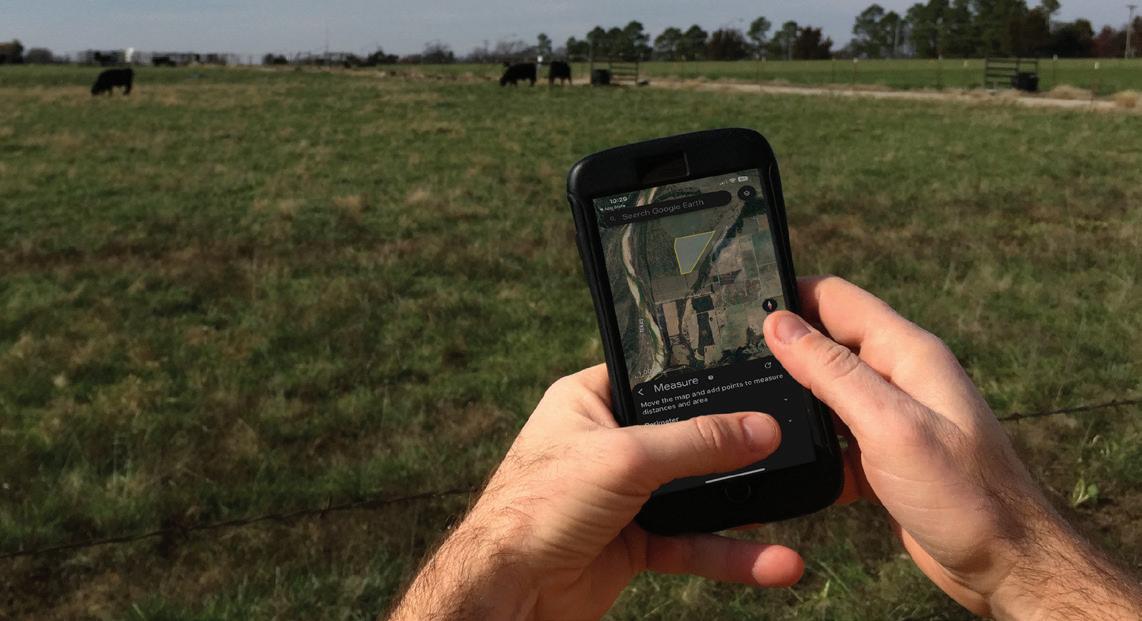
SOCIAL MEDIA ACCOUNTS TO FOLLOW
Get info and inspiration from what other regenerative ranchers and like-minded peers are saying on social media.
Harris family members began operating their Georgia farm as a living ecosystem in 1995, and now raise 10 species of animals in symbiotic relationships with each other.
whiteoakpastures.com
Learn about bison ranching and innovative methods with Dusty and Marisa Baker on their TikTok account, @crosstimbersbison.
bit.ly/cross-timbers
Enjoy scenic photos and videos from this veteran-owned-and-operated regenerative cattle ranch in Montana.
bit.ly/little-belt

GRAZING LANDS, FACEBOOK
Grazing Lands manages ranches using regenerative practices and works with landowners who want to see their land restored and managed for future generations.
bit.ly/grazing-lands
CONSIDER MINDSETS
SOCIAL AND EMOTIONAL FACTORS can play a part in a farmer’s willingness to try out regenerative agriculture methods, says Elizabeth Heilman, an ecologist and co-owner of the Regenerative Wisdom Agricultural Consulting Service. The stress of farming can cause one to hesitate to try new things. Heilman recommends trying out new practices on a smaller number of acres or out of the public eye to reduce stress, as well as finding a peer to work with for support.
READ MORE HERE: bit.ly/regen-mindset

Most ranchers are skilled at spotting the types of plants they don’t want – the invasives or non-desirables – from a mile away. But Noble Research Institute advisors challenge land managers to instead start looking for the plants they do want, and then manage for more as you make regenerative progress.
FOR MORE ABOUT PLANT ID AND DIVERSITY, SEE THE STORY AT: bit.ly/plant-id
THE CASUAL CATTLE CONVERSATIONS
Key Challenges During the First Five Years of Regenerative Ranching
Joe Pokay, general ranch manager at the Noble Research Institute, shares how to stay patient and adopt the right mindset to make it through the first five years of focusing on regenerative principles.
LISTEN HERE : bit.ly/1st5years
RANCHING REBOOT
Steve Swaffar: Recovery After a Wildfire, Management Concerns
This episode explores the multifaceted approach to ranchland management and wildfire mitigation, focusing on the benefits of prescribed burns and regenerative ranching techniques with regenerative ranching advisor Steve Swaffar.
LISTEN HERE : bit.ly/wild-fire-recovery

NOBLE RESEARCH INSTITUTE’S
LEARN MORE AT : noble.org/find-a-course
Harness the power and in your soil for better forage, better livestock and better returns.
AUG. 7-8
Fort Collins, Colorado
OCT. 2-3
SEPT. 18-19
Manhattan, Kansas
Canyon, Texas OCT. 30-31
Huntsville, Texas
Use your available forages to get the best our of your livestock and grazing land.
JULY 23-25
Perryville, Arkansas SEPT. 10-12 Ardmore, Oklahoma OCT. 22-24
Jefferson City, Missouri NOV. 13-15 Kingsville, Texas AUG. 26-28
Ardmore, Oklahoma SEPT. 23-26 Lincoln, Nebraska
Equip yourself with the knowledge to convert your grazing decisions into profit.
AUGUST 1
Women in Agriculture Conference, Edmond, Oklahoma
NOVEMBER 6-8
REGENERATE Conference, Denver, Colorado
DECEMBER 4-6
9th National Grazing Lands Conference, Tucson, Arizona

MULTIPLE MOVES PER DAY IS EASIER THAN FOLKS THINK, according to this regenerative rancher.
BY LAURA BRENNER
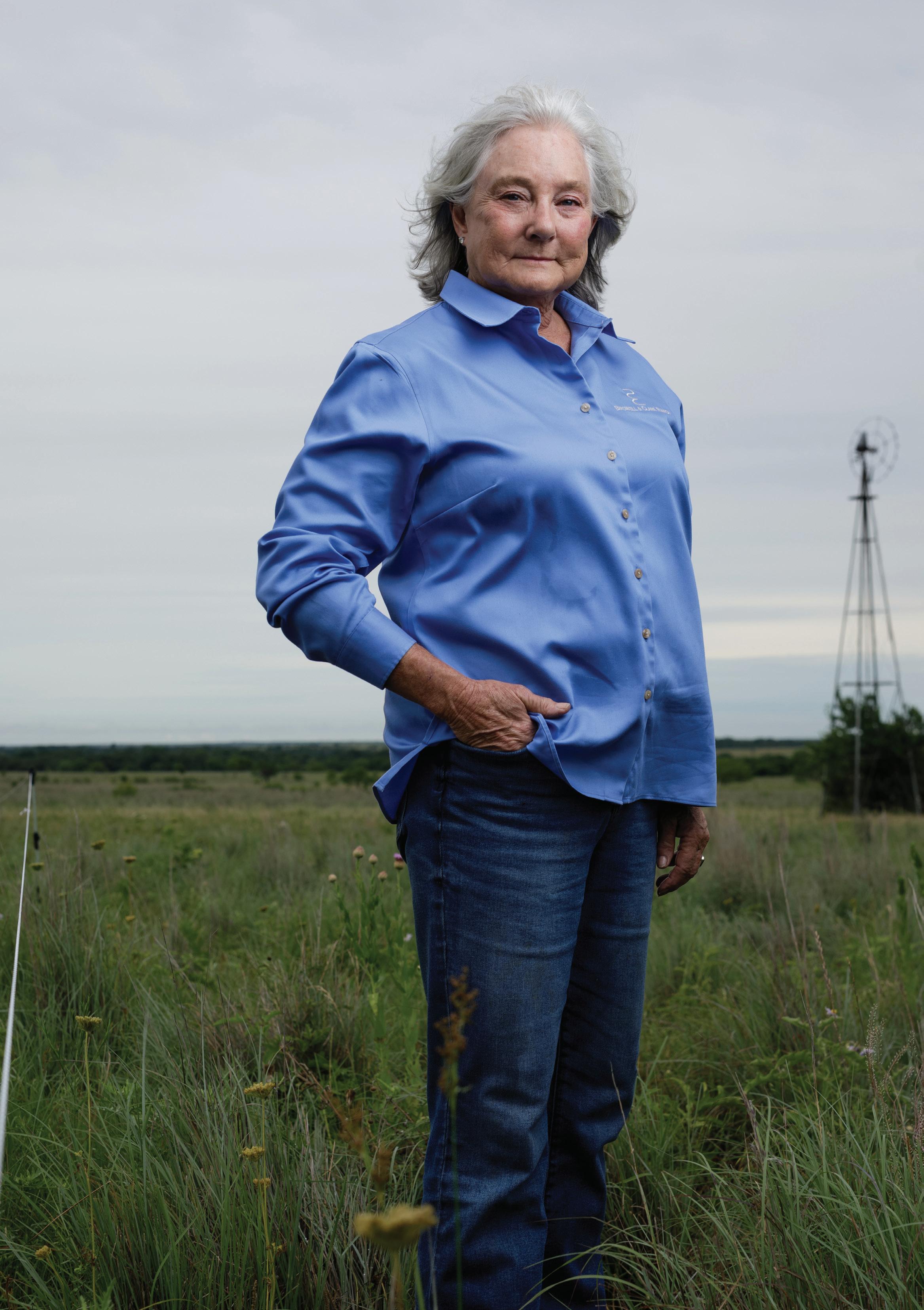
As the last of nine semitrailers leaves the Birdwell & Clark Ranch, the low clouds overhead release a symphony of rain onto the aluminum barn roof. Deborah Clark breathes a sigh of relief and transitions from her post at the truck scales into her dry barn office.
She spends a bit more time in the office these days as the keeper of the business side of the ranch, making sure the books are kept up and the paperwork is processed. But in the early days of the ranch, she worked side-by-side with her husband, Emry Birdwell, to transition their slice of Texas into a holistic, healthy ranch.
Birdwell & Clark Ranch is a 14,200acre spread in north-central Texas, close to the Red River. Clark describes it as a native tallgrass prairie bisected by the east fork of the Little Wichita River. Today, the ranch is home to some 3,400 head of stocker cattle that enjoy a constant buffet of forages. The cattle are moved frequently, as many as six times per day during the fast-growing season.
“It’s not prescriptive,” Clark explains of their grazing management style that responds to the forage available and the hunger of the cattle at any given time. “If you wanted to, you could move the herd into a large enough pasture so that you could take Saturday off because your kid was graduating or Sunday off because you want to go to church and then do something else. The person planning the grazing can control it. But yes,” Clark concedes to those who ask, “it does take somebody to be here and move [the cattle].”
The constant movements are also made easier on the cattle and the ranchers as a byproduct of their frequency. Clark explains the process, “We don’t force them to go to a gate. We go to where they are, lift up the wire with a PVC pipe, and the cattle just calmly walk under the raised wire to the next paddock. There’s no stress on the cattle.”
Frequently moving livestock might not be the easiest management style, but it has delivered on the goals the couple set out to achieve with their land.
“When we arrived, it was largely this plain of little bluestem. I didn’t realize it at the time, but it was a monoculture,” Clark recalls. “Now, through the

type of grazing management that we’ve implemented over the last 20 years, what is coming along is just this immense amount of diversity: little bluestem, switchgrass, Indiangrass, eastern gamagrass, and the forbs and legumes, all of which are very important to us, have just flourished dramatically.”
“ ... What is coming along is just this immense amount of diversity: little bluestem, switchgrass, Indiangrass, eastern gamagrass, and the forbs and legumes, all of which are very important to us, have just flourished dramatically .”
—DEBORAH CLARK
She’s also noticed, with the help of satellite imagery, the reduction of bare ground on the ranch. She estimates that during the drought of 2011, 25% of the ranch was bare ground — no grasses covering the soil. Today, she estimates only 5% is bare.
“Ranching holistically is looking at how grazing and management can help
improve your soil health,” explains Clark. “And when you improve that soil health, you improve the ability for your forages to flourish. And then when you’re doing that, you’re improving your ability to add more animals to your operation.”
The term ‘regenerative’ is used in favor of ‘holistic’ today, but the principles are nearly identical. Those principles are the foundation of Birdwell & Clark Ranch. Clark knows she wouldn’t be the rancher she is today without access to various workshops, seminars and educational courses. She also believes it’s best for ranchers to start slow and learn as much as they can as they go. Regenerative ranching isn’t about the destination, it’s a journey. Clark knows that better than most.
“We continue to change. I didn’t think we would make this last (change),” she quips, “but we’ve actually added sheep to our enterprises here. Even in our early 70s, we continue to change.”

The I’m a Regenerative Rancher series is a partnership between Noble Research Institute and Drovers magazine to present stories that showcase the resilience, adaptability, and innovation of family-owned agricultural businesses in the face of challenges and changing market conditions.

BY BURT RUTHERFORD

It began as a bond born on battlefields the world over. It came to fruition in the hay fields and pastures in the quiet solitude of the Montana mountains. And the regenerative restoration that has occurred with the Little Belt Cattle Company has old-timers taking an appreciative look over the fence.


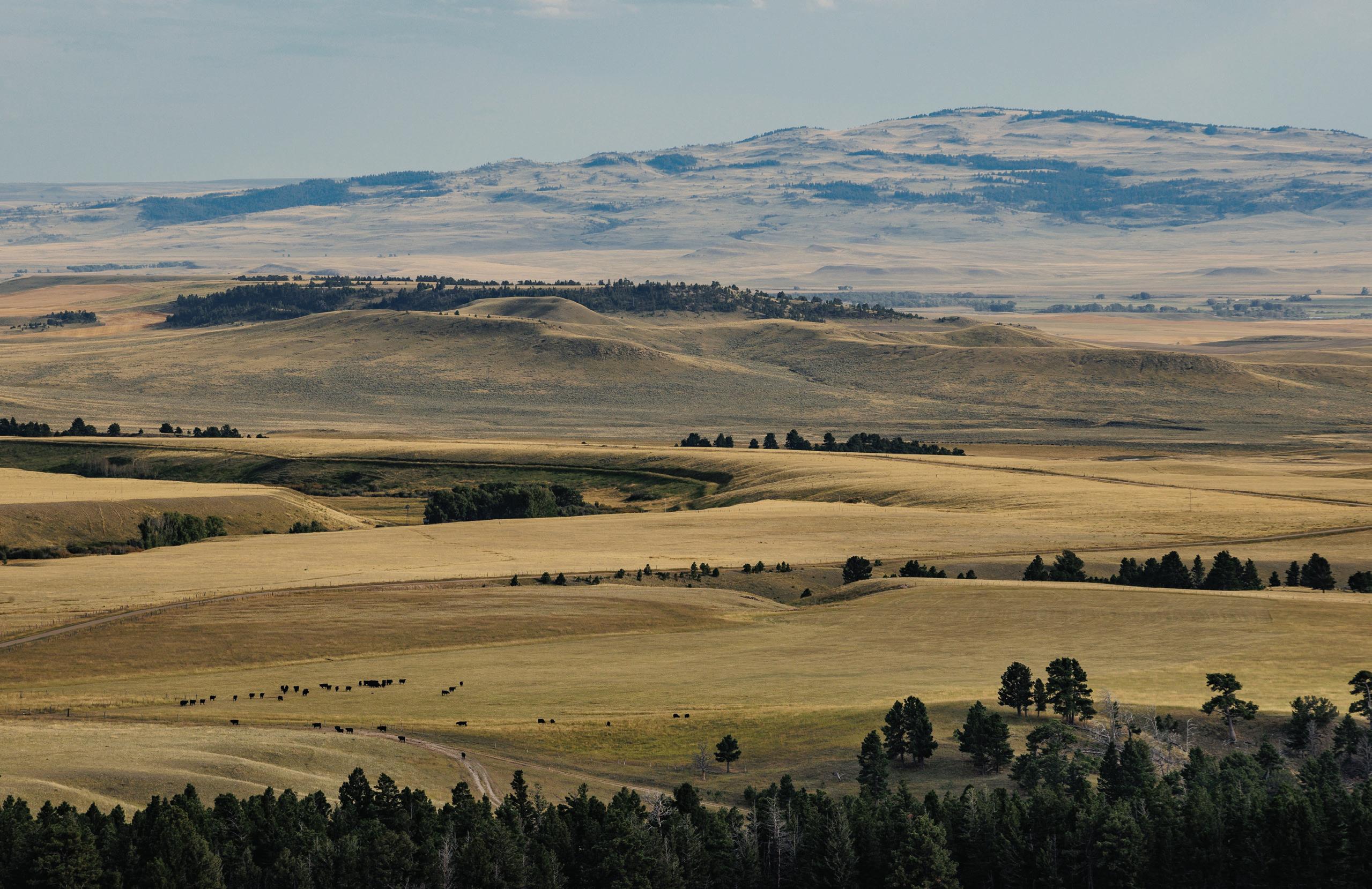
Greg Putnam and Tim Sheehy weren’t born into ranching. While serving their Uncle Sam as Navy SEALs, the two were deployed together and became friends. During down times, they talked and dreamed of becoming business partners in a ranching venture.
That dream became a reality in 2020 when they acquired Little Belt Cattle Company in central Montana.
But what do you do when you’re new to land stewardship and faced with pastures at the opposite ends of the grazing spectrum? Some hadn’t been grazed in years. Others had been grazed into something resembling a moonscape.
“If you don’t have the playbook from the last 150 years for the piece of ground you are managing, where do you start?” Putnam asks.
You start with an open mind, do a lot of research and ask a lot of questions. That led the business partners to regenerative ranching on their deeded and leased acres. In a way, they had no other choice.
To create their operation, the partners acquired three separate properties that they put together into one larger ranch. Those three properties had been under
different ownership, had been managed very differently, and some hadn’t been managed very well at all.
“So we basically had three separate properties that needed one overall grazing plan, but each of those properties needed its own individual plan within the overarching plan,” Putnam says.
“And the interesting thing is that there are regenerative practices that fit all those different problem sets,” he adds.
“The regenerative practices that we’ve adopted here are a number of different things, and I think one thing about our operation being basically a startup ranch is that it’s given us the flexibility to kind of cherry-pick different ways of doing things,” Putnam says. They spent a lot of time early on visiting ranches and working with people. “And it’s been great because we’ve got to see what works for some people and take those things and really apply them here.”
Their principal regenerative practice is a very set overall grazing plan and a rotational grazing plan where cattle change pastures frequently.
“They’re in some pastures, depending on animal numbers and size, for five to
seven days at the shortest, and up to 30 days at the longest.”
When green-up begins, they’ll start grazing the pairs on lower elevation ground in the early spring.
“We’ll start working those cattle up into our summer country, but really being mindful of the size of the pasture we’re on, the number of cattle that are on there, and the number of days specifically for that pasture to make sure that it gets grazed where we feel like it’s very even.” Beyond that, they don’t graze the same pasture with the same type of cattle at the same time every year.
“So we really focus a lot on rest periods. We focus a lot on the specific days that we’re on there,” Putnam says.
To accommodate the frequent moves, some pastures are split with electric fence. “We will absolutely use some high-intensity grazing depending on the pastures that we’re on, and then we will also use more of just your rotational style of grazing,” he says.
But much of the ranch is comprised of big, mountainous pastures that are already fenced.
“ So we basically had three separate properties that needed one overall grazing plan, but each of those properties needed its own individual plan within the overarching plan.”
—GREG PUTNAM
“So we really try to utilize what pastures we had when we took over management of this property, and basically try to best utilize those pastures for what they are, and also for what they needed for the states of condition that we found in those pastures,” he adds.
It’s worked and continues to work. Of the successes that he’s seen through implementing regenerative practices at Little Belt Cattle Company, Putnam says “No. 1 is the overall diversity of plant life, the diversity of wildlife and the overall quantity and quality of the forages in the different pastures.”
In addition to their deeded ground and private leases, they run cattle on Forest Service leases as well. However, as Putnam explains, the Forest Service isn’t known for flexibility in determining grazing plans on their allotments.
But they are concerned with land stewardship, and the Forest Service personnel found like-minded people at Little Belt Cattle Company.
“We’ve worked pretty closely with the Forest Service,” Putnam says, showing them what they have accomplished on the rest of the ranch.
“The grass on our deeded ground looks almost identical to the grass on the Forest Service,” Putnam says. “So when we started working with them and showing them what we were doing and why we were doing it and the results, they were actually really receptive to trying some new things.”
Now, Putnam and his crew are approved to implement regenerative grazing practices on their Forest Service leases.


“What they now allow us to do is put way more cattle (on an allotment) for way shorter,” he says. It’s basically the same animal unit concept but with a nod toward regenerative grazing practices. They move cattle about every two weeks instead of leaving cattle on the entire allotment for the entire summer grazing season.
When they took over the operation, much of the bottomland was used for hay production, an essential winter feed when dealing with snow and subfreezing temperatures.
“When we started out, we were putting up more hay (than at present), and I’d say we were basically haying the same fields that had been hayed traditionally on this property for the last 70 years,” Putnam says.
Then they took a look at the cost to put up hay versus using the hay fields for winter grazing. The hay fields are irrigated, so they experimented with one center pivot, fertilizing only half of the field. The fertilized part definitely put up a little more tonnage Putnam says, “but not enough in my opinion to make a difference in what it was costing to put synthetic fertilizer on the ground.”
By wintering the cattle on the hay fields and stockpiling the grass that, in the past, had been put up as hay, they extended their grazing season by several months, eliminated synthetic fertilizer and reduced the cost of putting up and then feeding hay. Instead, they drag the fields in the spring, spreading the manure and leftover hay as a natural fertilizer. They still have to put up enough hay to get the cattle through the hard winter months of January, February and March. Then spring green-up begins, and the cows have lush spring forage going into calving, which begins the middle of April.

“Our goal from the beginning was to do a truly start-to-finish Montana product with cattle that not only stays within 90 miles of Bozeman, but we wanted to keep them within our system so that we have quality assurance from start to finish through every step in the process,” Putnam says. “That was very important to us.”
They were already producing cattle for a national performance-based program, so they knew they had the genetics to produce quality beef. However, as they investigated the prospects for a branded beef system, they discovered that Montana restaurants weren’t serving Montana beef. They set out to change that. Their program begins with a cow-calf operation of primarily Angus-dominated genetics, as well as a yearling program and grainfinishing in a nearby feedyard.
The market for their branded beef is primarily high-end steakhouses in Bozeman and Big Sky, Montana, as well as direct-to-consumer sales through local butcher shops. To that end, grain finishing is important, Putnam says.
“The higher-end beef performance, you generally have a hard time getting that with grass-finished beef. So if you’re looking at the upper two-thirds Choice and Prime … we really have to be grainfinished, because (the restaurants) are all looking for that.”
Beyond that, by sorting for size when the yearlings are placed on feed allows them to stretch the times that cattle are ready for harvest.
“We have a very specific ration for each group,” Putnam says. “That allows me to span those cattle out over a longer period.”
That’s essential, because their restaurant customers demand not just quality
in the beef they serve, but consistency as well.
“With restaurants, you’ve got to keep consistency in your size of cuts, quality of cuts and deliverability.”
In other words, the next steak has to be as good as the last one, next week and all the weeks after that.
“One of the things I love about this beef production stuff is the fact that I like seeing the end result of it,” Putnam says. “What we’re trying to do is develop super-high-quality beef that’s good for the environment and good for the people eating it.”
So far, the end result has been positive.
“What I ultimately decided was we’re a 100% Montana beef company, to include being consumed here. And people really like what we’re doing,” he says. “We want people to say, ‘I’m buying this steak because I like what the company is doing and what they stand for.’ I also want it to be the best steak they’ve ever had.”
Putnam served in the Navy for 10 years, and as he was transitioning out of the military, he found work on ranches in Idaho and Montana. And it clicked.
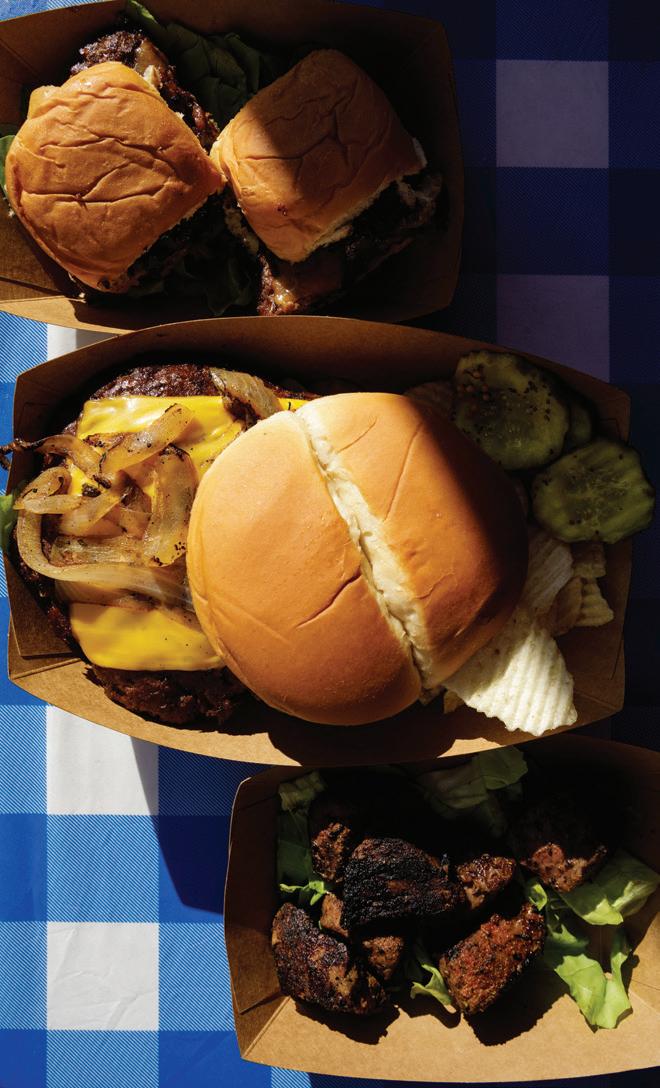
“It felt like I had the right shape peg for the right shape hole.”
Now he and the crew at Little Belt Cattle Company are giving other veterans transitioning into civilian life the same opportunity.
“ What we’re trying to do is develop super-high-quality beef that’s good for the environment and good for the people eating it.”
—GREG PUTNAM
“We started working with a number of veteran nonprofits to introduce veterans into the agricultural space.” They’ve worked with Montana State University to help veterans as well.
He realizes that ranching won’t click with every veteran they encounter. But he wants to give as many veterans as possible the opportunity to make that decision.
“What I try to do is figure out the best way to introduce veterans (to ranching), and I want to see two things. I either want somebody to say, ‘This is not for me,’ or ‘This is 100% for me and this is where I want to go with it.’”
That pays back in more ways than one.
“A big complaint is it’s hard to find good people,” Putnam says. “So you’ve got this great industry that has a ton of opportunity, and you have this group of people that are, to a certain capacity, desperate for an opportunity. What better way to solve two problems with one solution?”
Putnam looks across the lush, green pastures of Little Belt Cattle Company and likes what he sees. So do his neighbors.
“One guy told me the other day, whose family used to own part of this ranch and who grew up here, ‘This ranch has never looked better than it does now.’”
That’s the kind of across-the-fence compliment that regenerative ranching produces time and time again.

THREE OF OUR RANCH MANAGEMENT TEAM MEMBERS open up about the regenerative practices they’re investing in on their home ranches.
BY LAURA BRENNER
Nearly every person on our ranch management team grew up ranching under conventional practices. For generations, these ranchers followed a tried-andtrue business model that relies on expensive inputs and a few long days in a tractor each year to make hay. Adapting a different way of doing things on the Noble Ranches was one thing. But three years later, Noble’s ranch managers are integrating regenerative practices on their home ranches as well — and it’s paying off.
Since 2021, Noble’s ranch managers have had the opportunity most don’t — they get to answer the question, ‘What would happen if I tried (insert practice here)?’ With no risk to their bottom line, they’ve watched the benefits of regenerative ranching unfold in real time on Noble’s 13,500 acres of grazing land. Now three ranchers from Noble’s ranch staff share how they’ve evolved their mindset, and land management, at home in the last few years.



CHANCE TYNES, RANCH FACILITY MANAGER
Chance Tynes is the ranch manager at Noble’s 5,169acre Oswalt Ranch. But long before his employment with Noble, Tynes learned the industry through hard work at home. His family owned a ranch where his mother operated a beauty shop, and his father ran cattle. Despite his disinterest in the cattle business after college, Tynes found his way back to his roots through his passion for roping.
“I was involved in the rodeo business back then. So, I bought some roping cattle to keep my horse’s legs up and keep our practice involved,” explains Tynes. A few Corriente cattle turned into a small herd, leading Tynes and his father back into the cattle business.
Today, father and son manage around 650 acres and run a little more
than 100 cows across several tracts of land. Two years ago, Tynes started incorporating regenerative practices on his land. His first order of business: water access.
“I built a pond here about three years ago in one corner of the ranch, and I laid about 1,000 feet of water line so I could sort those cows off and have water in all corners of the pastures,” says Tynes. Updating his water access was step one. But he isn’t done there; when he’s able, he plans to invest in more fencing for smaller pastures.
Some of the land and cattle he manages on his own, while other herds and pastures are managed in partnership with his father. It’s a business dynamic that’s created some challenges as the younger Tynes continues to incorporate regenerative principles on his land.
Jon Willis’ ranch, Willis Simmentals, has been in his family for nearly 100 years. His great-grandfather purchased the original 80 acres in the 1930s.

JON WILLIS, RANCH FACILITY ASSISTANT
The dynamic between multiple generations managing the same ranch isn’t foreign to Oswalt Ranch’s ranch assistant, Jon Willis.
His ranch, Willis Simmentals, has been in his family for nearly 100 years. His great-grandfather purchased the original 80 acres in the 1930s and built the house Willis and his family live in today. His grandfather expanded the ranch to 540 acres, which is now shared among his children and grandchildren.
“It will mean a lot to me because a lot of people can’t say that,” Willis says of the upcoming 100-year anniversary of the original 80 acres being in his family’s care.
The Willis family runs a seedstock operation, selling registered Simmental bulls, heifers and embryos. You can find their cattle across Texas, Oklahoma, Arkansas and beyond.
Before his grandfather passed away in 2000, he asked Willis for one favor. “My grandad always was aware and wanted to learn to do more for the land,” he recalls. “His last wish before he died in 2000 was ‘be good stewards of the land,’ and it stuck with me. I take that to heart, and that’s what I try to do.”
Two years ago, Willis started applying some regenerative grazing principles to his ranch. He knows his infrastructure is a limiting factor, but he’s finding his reliance on fertilizer is a generations-long crutch.
“All of our pastures were, at one time, farmed in cotton, peanuts or small grains, and there’s just not a lot of topsoil left,” he says of his challenge in transitioning to regenerative. When those fields were turned into pastures, they were sprigged with bermudagrass, which needs fertilizer to grow well in his shallow Oklahoma soil.
Last year, Willis put out less fertilizer and moved his herd more frequently than his usual rotational grazing pattern. True to his word to his grandfather, Willis is trying to do the best he can for the land. But he knows to keep moving further down the path of regenerative, he needs to create water access to every pasture.

PAUL LUNA, RANCH FACILITY MANAGER
Taking care of the land is a sentiment that appeals to Paul Luna, too. He’s the ranch manager at Noble’s headquarters in Ardmore. He’s also managing land at home that was gifted to his family a generation ago by a family friend who helped raise his father.
Luna’s father managed the land as a dairy farm in the 1940s, then as a cattle ranch from the 1950s until the mid2010s, when his health declined. Luna now manages the land and the cattle business. When he was growing up, the ranch was operated conventionally, with one or two large pastures. Today, things look a bit different.
“Now, since I took it over, I started making smaller fields,” says Luna of the changes he’s made to the ranch. “It’s not like we do it here at Noble. More like a two-week schedule, just because of having to work, then take care of my dad. I don’t get out as much as I want to.”
But he was searching for a better way to increase profitability on his land even before he joined the team at Noble.
“The last time I sprayed my grass for weeds, the bottom of the hose on my sprayer got hooked on something and pulled off. There was a lot of money draining into the ground. I was trying to capture it before it all ran out of the tank, and I ended up taking a shower in that spray. I thought, ‘Man, there’s got to be a better way.’”
That was in 2020, a year before Noble announced its mission to regenerate 164 million acres of grazing lands. At the time, Luna recalls searching online, not for regenerative agriculture, but for ways to run more cows on the same acreage. The search led him to some of the same practices used on Noble ranches today.
When Noble announced its transition to regenerative, Luna was already on board and eager to grow his skills through Noble’s direction. But some of his fellow ranch managers weren’t so sure this was the right path.

Tynes recalls his first reaction to hearing Noble’s ranches would be transitioning from conventional to regenerative management.
“To be honest, I thought, well, if we don’t spray weeds and fertilize, we aren’t going to be in business very long,” he says. Besides reading about the idea in a few magazines, he didn’t know anyone who ranched that way.
It took Tynes some time to come around to the idea. He, like many ranchers, wanted to see the principles in action before considering changes to his ranch at home. Slowly, though, as he watched a system of management unfold before him, it started to make sense.
“I saw how it worked at (Noble), and I thought, I’m spending most of my
profit on fertilizer, weed spray, stuff like that,” Tynes says. “My dad still believes in a bunch of that, but on my own places, I’m going to try to reduce my cow herds a little bit and have enough grass to go through the winter. I’ve seen that it already works better; you make more profit without all the inputs — even with half the cattle you can make more profit.”
Tynes admits there were some barriers for him at first. Instead of mowing and baling hay on part of his ranch, he wanted to split up his pastures to allow more rest between grazing.
“We’re just kind of getting started on the fencing stuff so we can start rotating really well and maybe get some grass that we can hold over for the wintertime.
“To be honest, I thought, well, if we don’t spray weeds and fertilize, we aren’t going to be in business very long.”
—CHANCE TYNES
I want to let everything grow up and have good rest periods between grazing. So, maybe we can do a better job there and not have to feed hay as much.”
Transitioning a bit at a time is what makes sense for Willis’ ranch, too. Philosophically between his peers at the time, he recognized some of the principles right away. But the term regenerative wasn’t something he used to describe his ranch.
“I never really thought of it regeneratively, but you know, when you cut hay, you’re robbing from the soil. So, we’ve always cut, then tried to go back and feed that hay to where we cut it, so that nutrition — the manure and the urine — goes back into that land.”
The soil on his ranch is typical of southern Oklahoma, marginal and always three weeks away from drought conditions. In 2009, Willis bought a bale
processer to help build topsoil through organic matter. Instead of a concentrated feeding at one round bale, Jon broke down the bale into a windrow buffet, spreading out the impact of the cows over a length of pasture. Then he’d repeat the process in a series of rows until the entire field was naturally fertilized with leftover hay, and manure.
“For that part, I think I was ahead of my time, but we still fertilized,” Willis says. “But we’re trying to cut back, and doing the best we can with what we have.”
As a seedstock operation, raising cattle for genetic potential and selling registered bulls, he doesn’t have just one or two herds, but four. Which makes rotating and resting pastures more of a challenge.
“With four different groups of cows, it’s difficult to have enough fencing
“... we’ve always cut, then tried to go back and feed that hay to where we cut it, so that nutrition ... goes back into that land.”
—JON WILLIS
materials to (move each herd every day),” he explains. “So, I move them, maybe every three to four days.”
Noble’s philosophy — in business and ranching — is progress over perfection. Which is exactly how these ranchers are moving toward a regenerative model for their home ranches.


All three men are working hard to leave the land better than they found it. Luna and Willis hope the next generation of their families decides to come back to the ranch, but they know keeping the land in agriculture is not a guarantee.
“I’ve got two kids, both boys. They help me when I have to work cattle, but they live in Oklahoma City and enjoy that life,” Luna says. But one of his sons has hinted at coming back to the ranch someday. If his son does return to ranching, Luna thinks he will carry on the methods he started. “He’s big into the environment, so he thinks what I’m doing really helps the land.”
Willis’ family is a bit younger, with a couple of daughters still living at home. But he knows there’s a chance his family ranch will be divided further between his generation and his children’s generation, making it harder to sustain a cattle business. The original 540 acres is already partially on lease from his aunt.
“It’ll be sad when that happens,” says Willis, “because I’ve spent basically 53 years on that property and it’s not mine, but it is mine. I do the best I can to steward the land and make it more productive and better each day.”
Still, he admits some hesitation about his children wanting to take over the ranch.
“It’s a hard living. I want them to go out and do better than what I’ve done. Times are good, but it’s a lot of hard work. It would be nice if one of them would, but I’m not going to push it on them now.”
Choosing to return to ranching and developing a natural passion for the cattle business is how Tynes started his enterprise. It’s one he’s looking forward to developing through regenerative practices.
“I really believe in the future of this ranch,” Tynes says. “If I keep dozing some trees off here and there, and opening some of it up, and graze adaptatively, I’ll be able to run a few more cows on it and not have so many inputs. My future plans are to make it work on very little inputs and a whole lot more outcome, and maybe
“(One son) is big into the environment, so he thinks what I’m doing really helps the land.”
—PAUL LUNA
I won’t have to work at a job one of these days.”
Every ranch is unique, and every rancher knows his or her land, cattle and business best. Incorporating regenerative practices is the right move for these three ranchers to realize their goals. Whether it’s to keep a promise to improve the land, feed a few more cattle on the same acreage, or earn a better return on their business, regenerative ranching opens new opportunities.


TRANSITIONING YOUR RANCHLAND from a bermudagrass monoculture to more diverse native species is not a neat process. It involves embracing and managing the messiness that comes with change.
BY MADDY BEZNER
For ranchers focused on profit, animal health, soil health and wildlife, a shift from introduced grasses to more diverse native plants is essential to achieving these goals.
Mike Porter, senior regenerative ranching advisor at Noble Research Institute, explains that by working with nature rather than against it, ranchers can create more sustainable and resilient pasture systems.
The hallmark of good ranch management commonly has been perceived as well-manicured, monoculture pastures. These pastures, often dominated by bermudagrass, are kept looking pristine through regular fertilization, weed control and haying, mowing or grazing. However, this conventional approach comes with high costs and significant negative environmental impacts.
“Many ranchers now recognize the limitations of this system and the need for a different approach,” Porter explains.
“People looking to make this change want to improve their profit by reducing inputs, to improve their soils and ecosystem processes and to enhance wildlife habitat,” Porter says.
Bermudagrass monocultures require many inputs, such as fertilizers and herbicides, which are expensive and can degrade ecosystem processes.
Switching to native grasses helps reduce these needs.
Jim Johnson, senior regenerative ranching advisor at Noble, also emphasizes cost savings from less reliance on synthetic inputs as another reason to make the transition.
“There are significant cost savings from reduced input use. Healthier livestock need less veterinary intervention due to a more diverse diet,” Johnson says.
Native plants, with their deep root systems, improve soil structure and drought resilience. They also support a more robust wildlife habitat, boosting biodiversity.
“We’re trying to increase diversity, and we’re trying to reduce the need for inputs. The more diversity we have, the better the nutrient cycle works,” Porter says. “Ranchers commonly destroy their profit by buying too many inputs: fertilizer, weed spray, hay, tillage, mowing, and those types of things.”
Johnson and Porter agree the goal usually isn’t to eliminate bermudagrass entirely but to increase plant diversity, creating a more resilient and sustainable pasture system.
“There’s no recipe, there’s no prescription,” Porter says. “You have to look at what you’ve got, where you want to go, and then figure out the most likely way to get there.”
1. Assessing and planning: Start by assessing your current pasture conditions. Identify the existing plant species and soil health. Set clear goals for what you want to achieve and develop a plan for how to get there.
2. Encouraging native species: Native plants are well-adapted to local conditions and are more likely to thrive. Consider managing for native grasses and other forbs in your pastures.
3. Grazing adaptively: Stocking appropriately and moving livestock through different paddocks while leaving adequate residue and providing adequate rest allows plants time to recover and grow. This approach also mimics natural grazing patterns, promoting a healthier ecosystem.
4. Planting cover crops: In simple ecosystems such as introduced pastures or commercial crops, cover crops can protect the soil during off-seasons and provide additional forage.


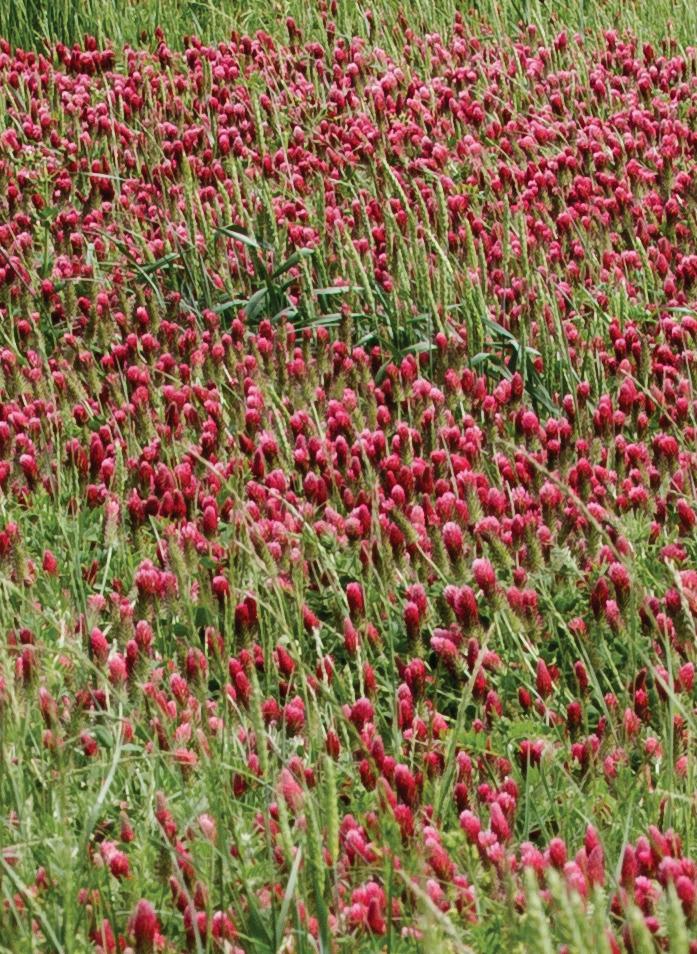


Native plants, with their deep root systems, improve soil structure and drought resilience. They also support a more robust wildlife habitat, boosting biodiversity.




Different methods can achieve diversity, but the choice ultimately depends on your goals, resources and long-term vision for your ranch. Porter usually encourages managing the natural succession of pasture. Succession is the natural progressive process of change from simpler soils and plant communities to more complex and usually more productive soils and communities.
“Plant communities are dynamic. They do not stay the same. They’re always changing,” Porter says. “What we do with the natural-succession approach is we manage that change.”
The natural-succession approach allows plant communities to change gradually without heavy inputs. This approach involves reducing most disturbances (e.g., fertilization, pesticides, mowing, haying and overgrazing), adjusting stocking rates and carefully managing grazing and recovery to encourage the growth of diverse plant species.
“This approach can be more practical for ranchers looking to reduce costs and negative environmental impacts than attempted total elimination of intro-
duced pasture through tillage and pesticides and then attempted total replacement through planting,” Porter says.
Ranchers may be familiar with a high-input approach to achieving diversity. While this approach can be practical for some, it probably is not practical for many, as it requires significant investment and major disturbances.
Brandon Baker, wildlife biologist at the Oklahoma Department of Wildlife Conservation, successfully used the high-input approach to reestablish areas of bermudagrass pasture to native grasses and forbs, in order to focus on wildlife habitat improvement.
“We’re seeing turkey and quail specifically. Before there was no quail present at all because it was a monoculture bermudagrass,” Baker says. “The native grass is also better for soil health. The root structure of native grasses establishes a lot deeper in the soil than bermudagrass.”
The natural-succession approach is ideal for those looking to embrace regenerative practices and work closely with natural processes. Ultimately, your chosen path should align with your
• Stop most spraying, fertilizing, mowing, haying and overgrazing: Stop spraying weeds and using synthetic fertilizers. These disturbances maintain the competitive edge of bermudagrass over natives.
• Implement rest periods: Allow your pastures adequate time to recover between grazing periods.
• Use prescribed fire: Fire is a natural ecological process that can facilitate natural succession.
• Manage grazing well: Practice top grazing, where you graze only the top parts of the plants to help them recover faster and keep roots healthy.
objectives and values for sustainable ranch management.
Transitioning from traditional pasture management to a more diverse and regenerative system requires more than just a change in management; it demands patience and a significant mindset shift.
“Ranchers need to understand if they’re going down this path, it looks messy to those used to a manicured landscape,” says Porter.
The transition to a diverse pasture system involves allowing native plants to grow, which usually appears untidy to those used to a manicured landscape, but such growth is crucial for long-term soil health and ecosystem balance.
Porter also points out that traditional overstocking practices aimed
at maximizing short-term beef production are counterproductive in the long run.
“It takes grass to grow grass. The more leaves you leave on a plant, the more sunlight it captures and the more roots it maintains, so the more it can grow,” he says.
Understanding and implementing proper grazing management — grazing only the top parts of plants and allowing sufficient recovery time — is vital for maintaining healthy pastures.
“The most profitable space for most people or most years is when they’re right below carrying capacity,” Porter says. “Carrying capacity is the number of animals that the land can support for the period of time you’re grazing, without hurting the animals or landscape.”
Ranchers can successfully navigate this transition toward more diverse forages through careful planning, monitoring and adaptability.
“Be patient. Have realistic goals, and educate yourself ahead of time on what’s realistic,” Johnson says.
Embracing diversity and regenerative practices means playing the long game. It’s about working with nature, not against it.
“There’s no one way to do it. It depends on the situational context and how the land reacts. It boils down to respecting and encouraging diversity, stocking appropriately below carrying capacity, and managing grazing and recovery,” Porter says.
In the end, transitioning to diverse pastures isn’t just about swapping bermudagrass for native grasses. It’s about building a resilient, productive and sustainable ranching system that benefits the soil, livestock, wildlife and your bottom line.

Northern bobwhite quail and other wildlife depend on grassland diversity.
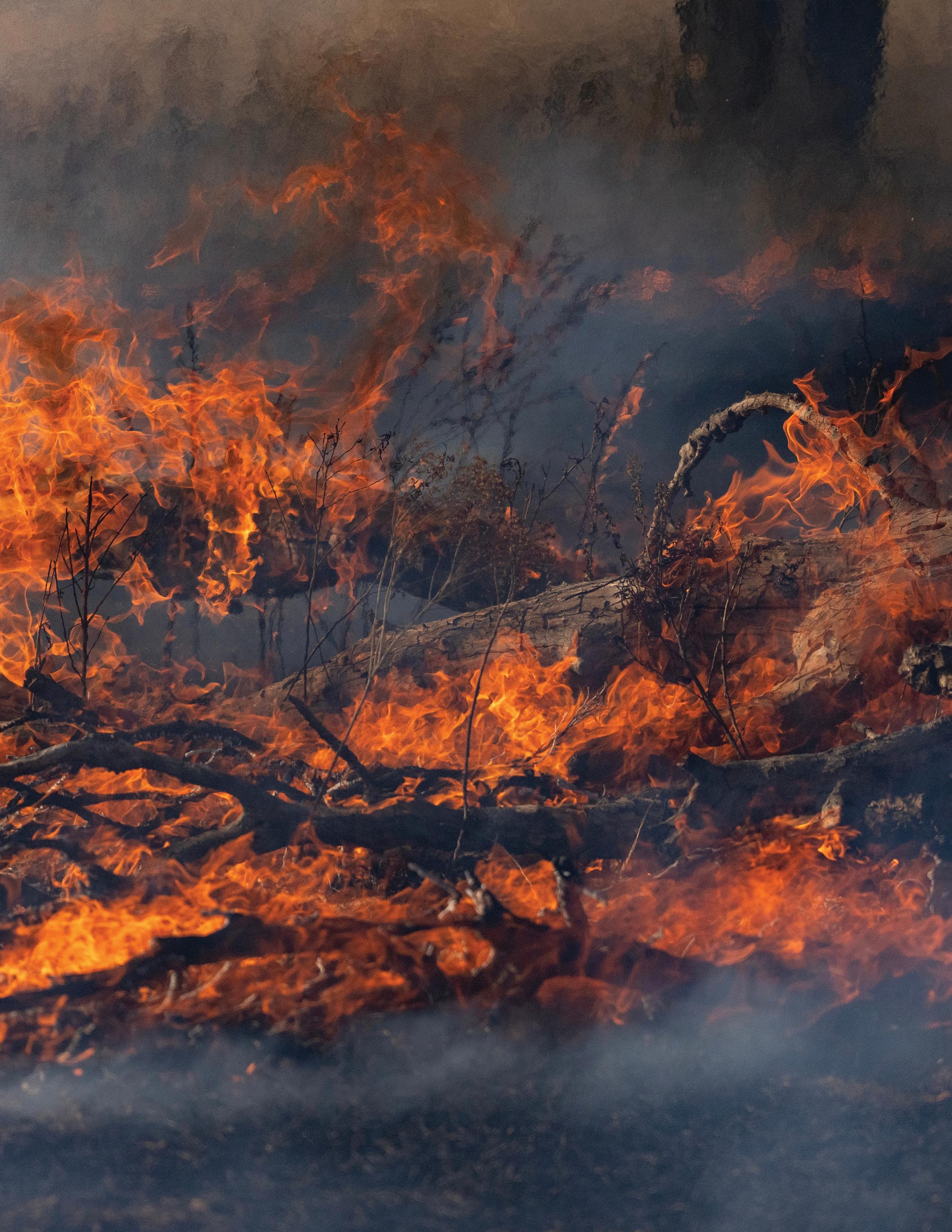
LARGEST WILDFIRE IN 2024, experts and ranchers weigh in on the future of firefighting and ranching in the state.
BY LAURA BRENNER AFTER TEXAS’
hat’s feed today is fuel tomorrow. That’s how Mike Turner thinks about his grazing pastures along the 7-mile stretch of highway that lines his ranch in the Panhandle of Texas. During fire season, a vehicle dragging a chain on the road could throw a spark into his standing grass and become ground zero for a wildfire.
In Texas, especially in the Panhandle, ranching and wildfires must coexist. For thousands of years — as long as large herbivores have grazed in what are now the Southern Plains — wildfires have regulated the ecosystem and maintained the shortgrass prairies where so many ranchers make their living.
It’s a fact ranches and community leaders grapple with: wildfire presents both opportunity for the landscape to thrive and danger to the growing number of lives and homes within the state.
Aspark from a power line, not a vehicle, was determined as the cause of the spring 2024 Texas Panhandle Wildfires. The fires damaged more than 1 million acres, making it the largest wildfire in Texas history. But the start of the fire is only one part of the story. Luke Kanclerz, head of the predictive services department at Texas A&M Forest Service, says the recent Texas Panhandle Fire was truly caused by a wet spring the year before.
“Copious amounts of rainfall in late May and early June of 2023, during the early part of the growing season resulted in a very robust grass crop and that Canadian River drainage,” explains Kanclerz. The area is mostly grazing lands, but he speculates the cows just couldn’t keep up with the surplus of forage available to them. As his team evaluated the risk of fire, the concern for an early spring wildfire was dampened by a wet winter.
However, after all of that rain and snow, the weather — and Kanclerz’s outlook on
“ When you have this much grass on the landscape, it requires less drying and fire weather to produce increased fire activity.”
—LUKE KANCLERZ
the fire season — shifted. An abnormally warm and dry spell left pastures wellstocked with dormant forages.
“When you have this much grass on the landscape, it requires less drying and fire weather to produce increased fire activity,” he says.
In other words, those dormant forages became fuel.
The topography of the area played a part in the fire’s ability to move quickly, as well. The Canadian River drainage basin, where the fires took place, runs east to west, perfectly in tune with the westerly wind blowing on those late February days. The wind pushed the fires east, across the drainage, faster than predicted. All these factors created a favorable fire environment, which Kanclerz and his team predicted then. But what they couldn’t have predicted was the magnitude of the fires due to changing weather patterns.
“This one went against the climatological brain with this fire being during an El Niño year,” Kanclerz says of the Smokehouse Creek fire. “But it just goes to show that you know the impacts of fuel; the setup for this fire began almost a year ago.”
That’s his biggest takeaway from this fire. He and his team are studying the Smokehouse Creek and the Windy Deuce fires to improve their ability to predict fire patterns in the future. The valuable lesson here for him is that weather is an indicator of fire environment, but so is fuel load.

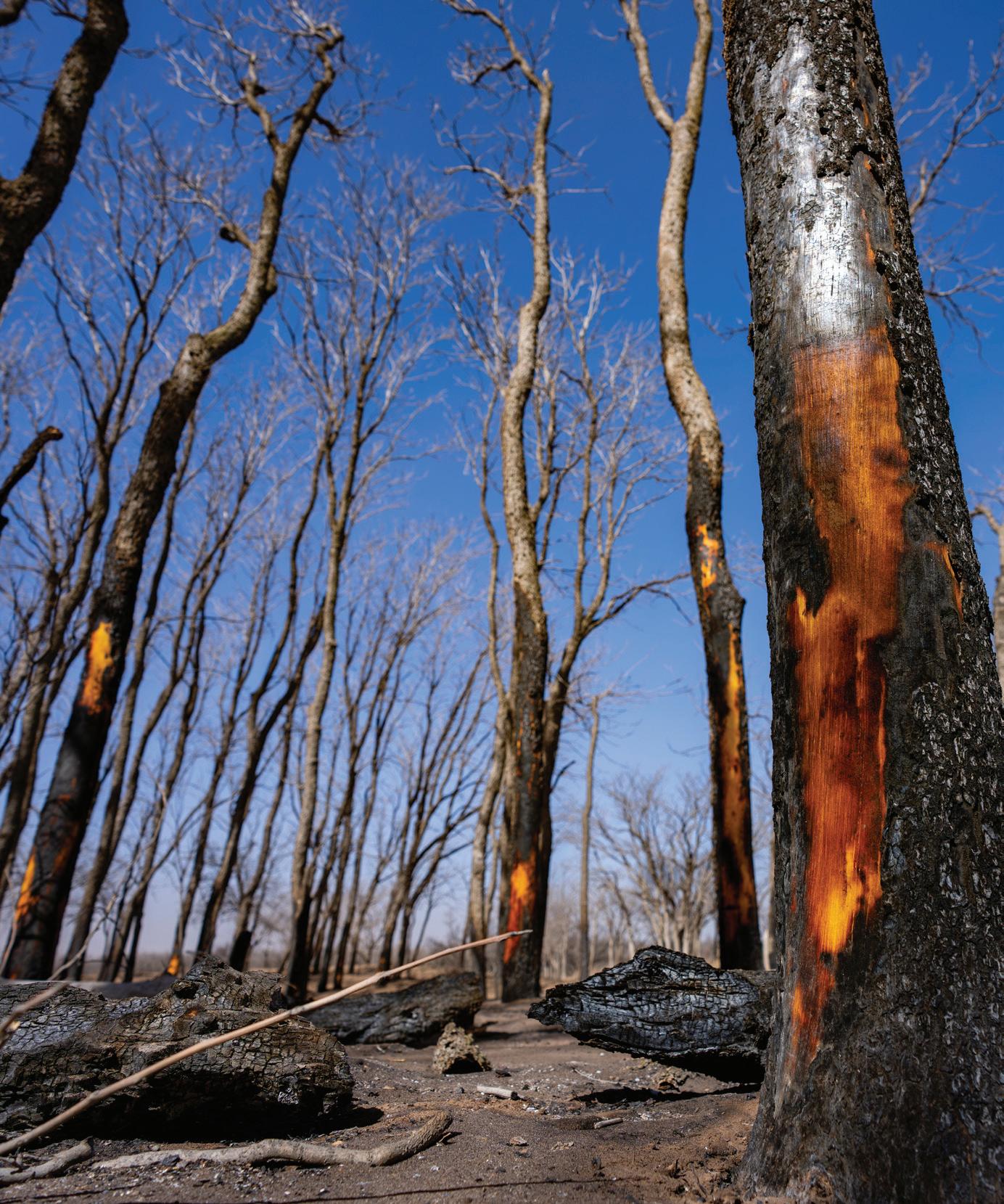

What constitutes fuel for fires should be on the mind of every rancher, and their town-dwelling neighbors. The Panhandle Wildfire was so devastating not only because of losses ranchers experienced but also how it affected the towns and cities rapidly expanding throughout the Panhandle.
The growing population in rural Texas communities is at the forefront of Jake Donellan’s mind when he thinks about the future of wildfires in Texas. Donellan is the head of the field operations department of the Forest Service.
Balancing the ecosystem’s need for fire with the risk to local communities and ranchers is a big job. Enough for the Texas A&M Forest Service to staff 315 firefighters in the state. Donellan oversees the team of firefighters; he’s also spent plenty of fire seasons fighting fires across the state. During his 24-year tenure with the state agency, he’s watched the landscape change, communities expand and knowledge about fire safety stagnate.
In 2011, Donellan helped Walker County write the first community wildfire protection plan in Texas.
“The county got together with all the folks who may be called out or affected by a wildfire and started to develop a plan of action,” he explains of community wildfire protection plans.
“It becomes a road map for community best practices and makes sure everyone’s on the same page in advance and not scrambling at the moment of the emergency to try and work out those details.”
Helping communities plan their response to wildfires is essential, and more communities have plans in place today than ever before. But the biggest fire threat facing Texans is other Texans. The population of Texas is rapidly expanding. Between July 2022 and July 2023, the United States gained 1.6 million people — and 30% of them were Texans. And it’s a decade-long trend that is at odds with firefighting.
“Often, new people come and they’re unfamiliar with the fire in the environment,” laments Donellan. “They’re unfamiliar with how most fires, 90%, are

human-caused. And so, they actually contribute to those fire starts.”
Population growth also feeds urban sprawl. Large swaths of grasslands are replaced by smaller parcels, ranchettes and suburban style neighborhoods.
“When it’s out in the grass and the plains, it’s pretty easy in terms of your risk management and getting [firefighters] in and around there. But as you introduce more and more people into the landscape, you have to navigate in and around homes, and help protect them as well.”
Suppression, rather than management, of wildfires is the path ahead for the Forest Service, despite the benefit fire has on the ecology and productivity of grazing lands.
For woodland ecologist Karl Flocke, the intersection between fire and ecology is his specialty. He’s the program leader for water resources at the Texas A&M Forest Service. He’s keenly aware of how important wildfires are to the sprawling Texas landscape, and to cattle grazers.
“Fire removes a lot of that standing vegetation, gives room for new grasses to grow up. Those new grasses and plants are often a lot more palatable, a lot more enjoyable actually for grazing animals,” Flocke explains. “In the absence of fire, we see a lot more of that woody vegetation come up, and from a grazing perspective, that’s not desir-
able, because we want to maximize our rangeland, our grasslands, and so fire is a little bit of a silver lining.”
Mike Turner has seen this play out on his ranch, too. It’s a scenario that’s contributed to his post-fire grazing strategy.
Last October 2023, after a day of loading cattle onto trucks for a move to a different ranch, Turner looked up to see a plume of smoke rise into the sky. His ranch was on fire.
A Class 2 prescribed burn planner, he jumped into action. Less than seven hours later, the fire was out, but the damage had been done. Turner lost a 20-acre section of his grazing land, during a drought. He practiced regenerative grazing for years, but still didn’t know how the soil would rebound.
“ In the absence of fire, we see a lot more of that woody vegetation come up and from a grazing perspective, that’s not desirable, because we want to maximize our rangeland, our grasslands, and so fire is a little bit of a silver lining.”
—KARL FLOCKE
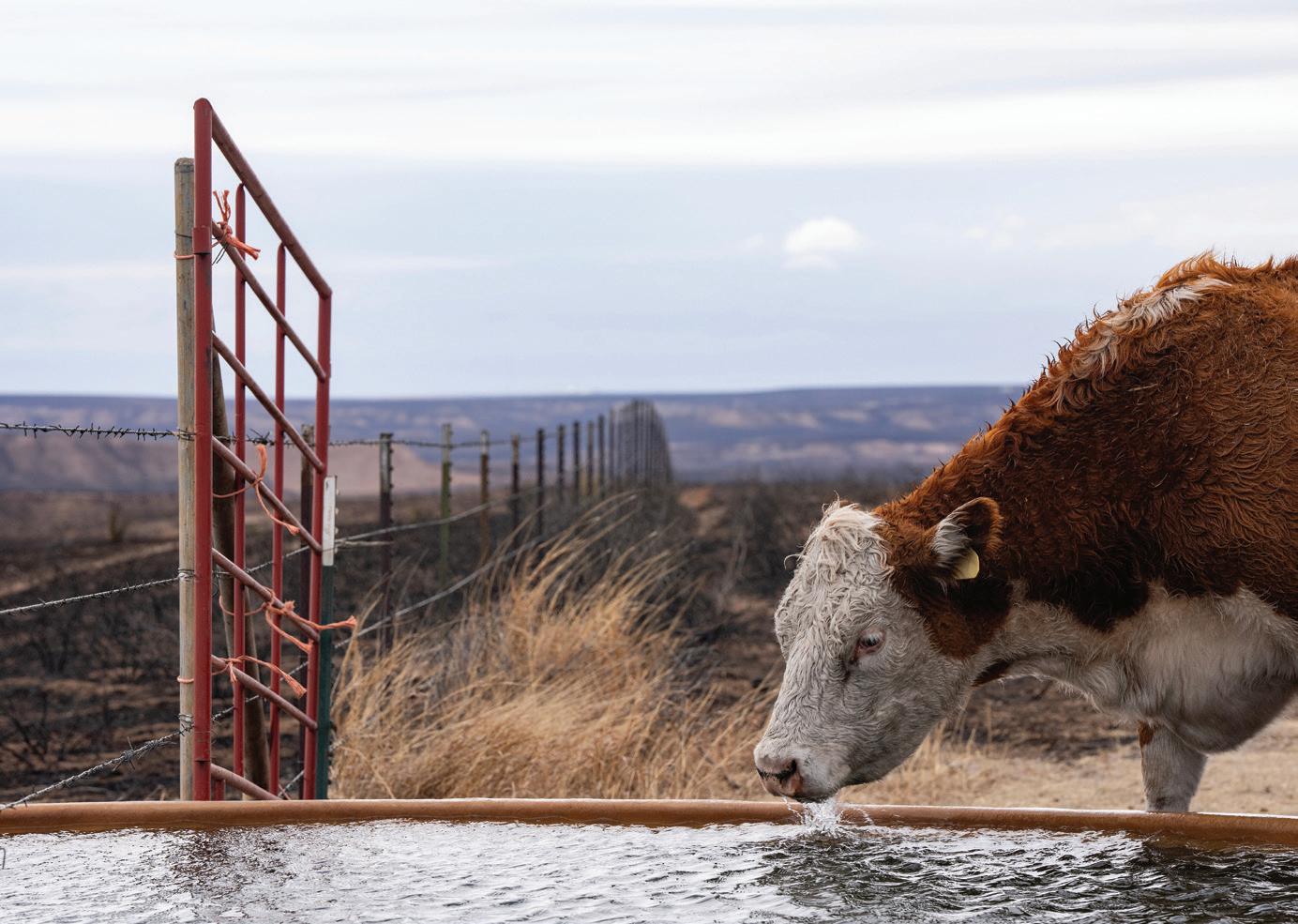

“I didn’t put a hoof on that for nearly 14 months,” Turner says of the aftermath of the fire. Eight months after the fire, he started to see green return to the pasture. Then, he had a decision to make: graze that pasture or continue letting it rest.
“Cattle will always go back to an area that has been recently burned because the regrowth is going to be more palatable, younger and tender,” he says. “And you can actually do a lot of damage to that area if you let cattle in there too early.”
Three years later, he knows the long resting period was the right decision.
“In 2023, I had upwards of 2,100, maybe 2,200 pounds to the acre, which was good. That’s the kind of stuff that you want to see come back after a fire,” Turner says of the previously scorched pasture, which carried nearly twice the forage load of other, neighboring fields. The fire also eliminated the encroaching yucca and other woody species in his pasture, saving him some labor and equipment costs.
Turner knows he was lucky this time, such a small piece of his ranch burned. So many ranchers impacted by the Panhandle Wildfires don’t have green pastures to hold cattle on until the burned ones heal. Many ranchers lost livestock or suffered high rates of injuries. Others will have to sell their remaining cattle. A few may be forced to sell the ranch altogether.
Despite the bleak outlook for many, Turner is hopeful. He knows ranching and wildfires are inseparable in the Texas Panhandle. His neighbors understand that too.
“Ranchers are very resilient, and that’s one thing. And we have short-term memories too, because we always forget about the hard aspect, which, maybe that’s a fail-safe for us,” he quips. “I’ve had the privilege of working with a lot of these producers that have been born and raised [in the Panhandle], and yeah, just say they were cut from a different piece of cloth. They’re just tough, I mean really tough. And I’m proud to be associated with them.”
Because the Southern Plains landscape is fire-dependent, controlled burns — often called prescription burns — are an effective method to lower a ranch's fuel load and protect assets in event of a wildfire. Will Moseley, a regenerative ranching advisor at Noble Research Institute, is an expert in prescription burning on ranches. He shares insight for managing wildfire risks through prescription burns.
What factors suggest a ranch is ready for a prescribed burn?
Everything will be based on your annual rainfall that year, as well as how much you are producing and what your stocking rates are compared to that. So, if you have good years, you can burn more frequently than when you’re going through a longterm drought.
How long do you need to withhold cattle after a prescribed burn?
If you have soil moisture, your land is going to respond a lot quicker than if you have been overgrazed and you had bare ground. We did some summer prescribed fires in 2011 when we had a bad drought here. In areas where we had good soil moisture and a history of good cover, good grazing, we saw regrowth during the drought. That showed me the power of having good soil cover, good soil moisture.
Will a prescribed burn on my ranch drive away the deer, turkey and other wildlife?
A northern bobwhite quail, for example, might use 40 acres, and so when you talk about a million-acre wildfire, it’s going to take several years for bobwhites to return, because they need last year’s growth to nest in. Turkey, deer, species like that will be able to come back into those areas faster. Our grasslands need fire. When we remove fire from the landscape, it actually degrades habitat for most species. So long term, controlled burning is a benefit for wildlife habitat.
Why is prescribed burning a valuable tool for regenerative ranchers?
Prescribed burning, because it doesn’t get out of control like a wildfire, doesn’t kill roots. It stimulates diversity, and diversity is the most important thing when discussing community dynamics — plant diversity and animal diversity. And when we talk about soil health, I think fire, when used properly, absolutely is a part of creating healthy soil. Like I said, these prairies were maintained with fire and herbivory for centuries and centuries.
What’s the best way to prepare for a prescribed burn on a ranch?
I would encourage people to contact their local prescribed burn associations. They are typically a very producer-led organization with regional chapters. Producers get together, help each other out, and share equipment, experience and labor. They have educational opportunities and training days, too.

WANT MORE INFORMATION or resources for prescribed burning on your ranch? Scan the code or visit www.noble.org/tag/prescribed-burn
RETIRED BANK PRESIDENT AND RANCHER
Henry Weinzapfel is a dedicated supporter of Noble’s mission.

BY LAURA BRENNER
A late-model pickup truck rattling down a county road is so mundane a scene in Muenster, Texas, the sound may barely register to nearby residents. Henry Weinzapfel prefers the drive to his ranch that way, a bit of anonymity after a career in the spotlight.
Weinzapfel, retired president of the Muenster State Bank and former mayor of Muenster, knows a sound investment when it crosses his desk. The second-generation banker is a long-time supporter of Noble Research Institute and also a ranch owner.
“I just enjoy going out and driving around, and I enjoy fishing,” Weinzapfel says of his ranch. “I used to enjoy hunting, but I really don’t care to kill anything anymore. While my wife was still alive, we always went out, had picnics, a fire, roasted weenies, s'mores, and that kind of stuff. It’s just a great place to go out and hang out.”
Weinzapfel’s interest in landownership stemmed from his father, who purchased 1,000 acres of Texas ranchland in the 1930s as an investment. He remembers his father leasing the land to a local rancher for many years. When that rancher retired, Weinzapfel and his brother-in-law tried their hand at managing the ranch, an experience Weinzapfel looks back on and chuckles at now.
“We asked my dad if it would be all right if we took over the ranch and see what we could do with it,” he explains. The duo hired a man from town to take care of the place. He didn’t realize his error in hiring a man with little ranching experience until his father-in-law, a successful rancher, questioned why the ranch was selling off cattle.
Weinzapfel recalls the first time he heard about Noble Research Institute, then known as The Samuel Roberts Noble Foundation. “I guess back when I was 8 or 10 years old, I remember my dad took me to a plot where (Noble was) doing experiments and planting different stuff.” It was a place his father, and later Weinzapfel himself, could find trusted advice.
Since then, he’s heard folks talk about Noble and tried to keep up with the organization’s research and findings. He even trekked back to Ardmore a few times.
Over the years, Noble has become a resource for Weinzapfel. “I went up there for a couple of different seminars over the years,” he says. “(Noble has) all these experts and scientists with PhD’s and master’s degrees. And so, it’s just a world of knowledge.”
Weinzapfel has regularly supported Noble through financial contributions. He’s making an investment both in the organization and in the future of the land.
“We were told the cattle were old and needed to go, so we listened. My father-in-law knew differently. He said ‘they’re not old, they were just thin and underfed.’ Well, we decided then that we were not cut out to be ranchers,” Weinzapfel said with a wistful sigh. “So, Dad leased the place out to someone, then he finally sold it a few years later.”
Despite his unfortunate early foray in ranching, Weinzapfel never let go of the idea he’d been introduced to as a child — cultivating something beautiful and valuable from the rugged Texas landscape. He purchased his own piece of Texas dirt in the late 1980s.
The decision to support Noble through a financial gift was easy. When Weinzapfel received a letter from Noble a few years ago, he mailed back a check. Since then, he has regularly supported Noble through financial contributions. He’s making an investment both in the organization and in the future of the land.
Ranchers across the country have access to Noble’s ‘world of knowledge,’ as Weinzapfel calls it. But it’s the rancher in his backyard who reminded him of the impact his gift has.
During a recent mailbox chat, his neighbor shared that his son spent three days in Ardmore at a Noble course.
“They’re doing a lot of work cleaning up the place,” Weinzapfel said of the neighboring ranchland. “It’s quite similar to mine; it has a lot of trees, some hills and creeks. It’s a nice place, and they’re taking a real interest in doing their own cattle operation. It will be interesting for me to watch and see what they do.”
At 90 years old, Weinzapfel has had time to reflect on his land and the care he’s given it. While he wishes he would have done some things differently, he’s hopeful for the future of ranching. It’s a generation he’s investing in to get it right.
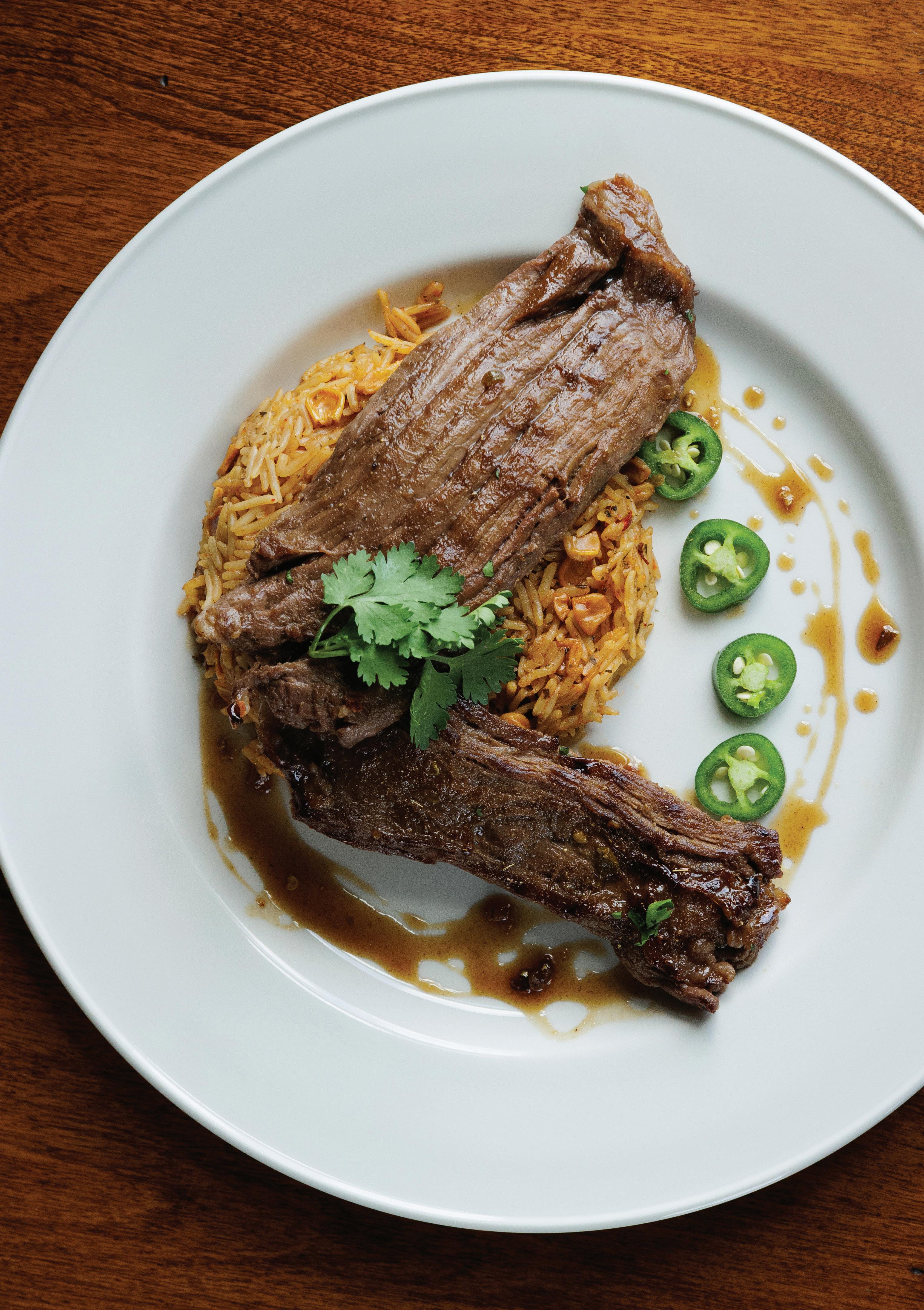
{ 3 pounds Certified Angus Beef® sirloin flap or skirt or 2 flank steaks
{ 1 cup tamarind concentrate
EXPERTLY CRAFTED in the Certified Angus Beef® brand test kitchen, this recipe offers a delectable fusion of tangy, sweet and spicy flavors that will elevate your steak experience to a new level. 6 HOURS (including marinade)
{ 2 tablespoons molasses
{ 2 tablespoons Worcestershire sauce
{ 8 canned serrano peppers, thinly sliced into rounds
{ 2 teaspoons ground coriander
{ 2 teaspoons ground cumin
1. In a small mixing bowl, combine tamarind, molasses, Worcestershire, peppers, coriander and cumin to make a marinade. Divide in half; reserve one part in refrigerator.
2. Cut raw steaks with the grain in 3-to-4-inch wide pieces. Place steaks and remaining marinade in a zipper-locking plastic bag, removing air and uniformly coating steaks. Refrigerate at least 6 hours; overnight preferred.
3. Preheat grill to high. Pat steaks dry and sear on each side to develop a good char (2-3 minutes per side). Baste with reserved marinade. Transfer to cooler side of grill to finish to medium rare or your desired doneness.
4. Rest on a cutting board 5 minutes before slicing thinly against the grain to serve.


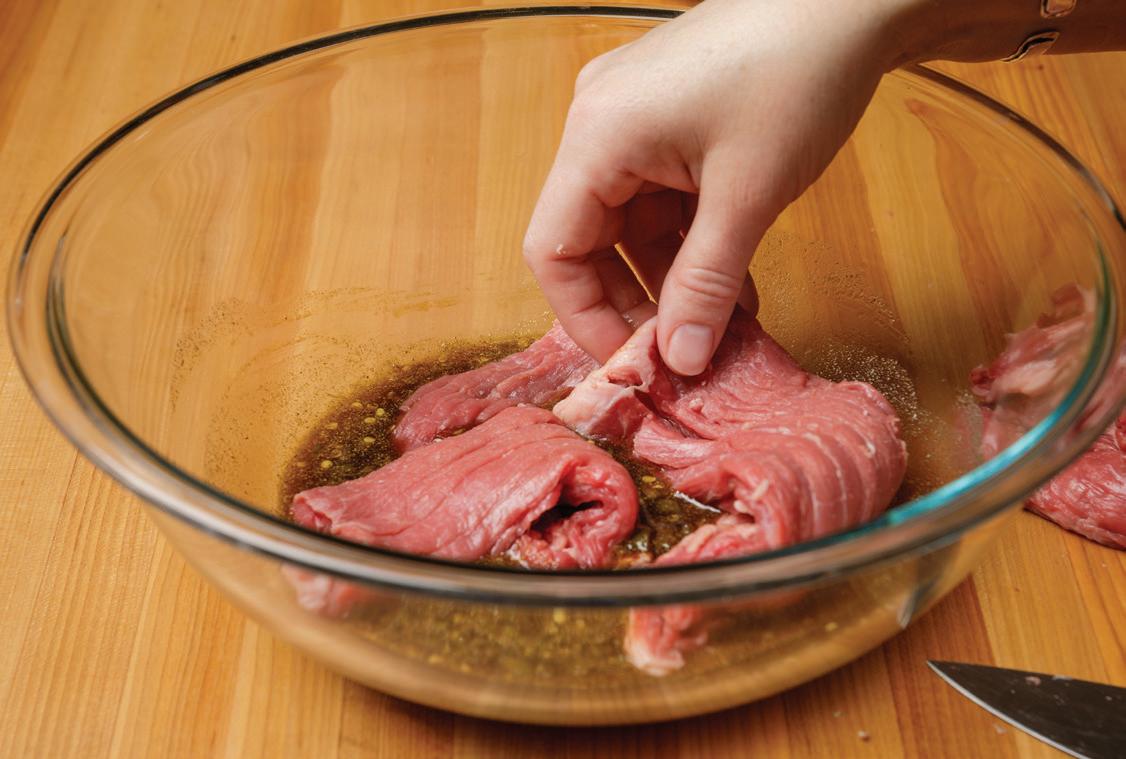

DEVLON FORD, regenerative ranching advisor at Noble Research Institute, shares his advice and methods for fencing water gaps and low areas. Planning and maintaining water-gap fencing is vital for effective livestock management and protecting your property.
What types of water gaps have you encountered on your ranch?
Water gaps can vary depending on the terrain and water flow. They can occur in various low areas, not just creeks, and they need different approaches depending on the water flow and animal species grazing the area. Water gaps can be areas of erosion, seasonal flows or low spots that collect water. Depending on your property, you may need to construct a fixed water gap or a swing gap.
What fencing methods do you use for water gaps?
When it comes to fencing methods, you can use a range of materials like barn tin, dog chains, or polywire weighted with rocks. These materials are flexible and can move with the water flow, preventing damage to the fence. For more stable and continuous electric current, high-tensile wire is excellent. It spans across low areas and prevents cattle from crossing, even when water levels are low. Polywire is another practical and inexpensive option, though it might need replacement after heavy flooding.
I have a stream that runs into and across my ranch. Do I need to worry about a water gap?
Yes. Water gaps are essential for ensuring your livestock stay within your property lines while allowing water and debris to flow through without too much damage to your permanent fence. The ideal water gap functions as a floodgate, maintaining animal containment without obstructing the natural flow of water.

What should I consider when planning a water gap?
There are several factors to consider:
1. Depth and width of the water: Understand the dimensions of your stream, creek or other water bodies.
2. Water source and flow: Consider both the lowest and highest water levels throughout the year. This depends on whether your waterway spans a few feet or several feet. Note that in some states, it is illegal to fence navigable waters, so be sure to check local regulations before installing any fencing.
3. Debris control: Consider how sticks, branches and other debris might accumulate in your gap, potentially causing harm.
4. Soil stability: Determine if your soil is sturdy or erodible, as this will affect your fence’s durability. The banks of creeks, streams and other waterways hopefully have plants growing close to the edge. Growing plants will help hold the soil in place and are less susceptible to erosion than bare soil. These covered areas are a good place to install T-posts for strength and tension, while fiberglass posts are inexpensive and better for use in bare soil along the banks and the bottom of the channel.

How should I determine the appropriate type of fencing for water gaps?
Choosing the right fencing for water gaps does not follow a universal rule, as each site’s characteristics vary. Consider the following essential elements for effective water-gap fencing:
1. Post placement on both banks: Install posts about 2-3 feet from the edge of the water to avoid areas susceptible to erosion.
2. Wire or cable across the top: Attach a horizontal wire at the bottom of the posts, which corresponds to the top of the bank.
3. Filling material for the gap: Utilize materials such as strands of electric wire to span the U-shaped gap down to the water’s surface.
The water level in my creek varies. How should I account for that in our water-gap fence?
The key is to ensure your gate matches the land’s contour. For high water, the gate should swing to float and allow debris to pass. In low water, it should prevent livestock from crossing underneath. In low areas without consistent water, fixed water gaps using strands of barbed wire or brush can help keep your gap effective in varying water levels.
How do different species impact my water-gap solutions?
Different animals need different water-gap designs. For cattle, I have used brush as a barrier when in a hurry, since they tend not to push through dense vegetation. However, sheep and goats can navigate these barriers, so you will need more secure options like high-tensile wire or polywire fencing. These materials adjust to varying water levels and can contain smaller, more agile animals. Electric fencing is also useful for sheep and goats to prevent escapes through small gaps.
Which materials are most suitable for constructing a water-gap fence?
For water-gap fencing, opt for galvanized pipes or wood that has been treated for high-moisture environments. These materials are ideal due to their durability in wet conditions. Ensure that the support posts are securely driven into a stable part of the bank.

Is it possible to extend an electric fence across a water gap in my cattle pasture?
Yes, you can. I recommend using a current limiter on your water gap section. This device maintains a charge to the rest of the fence even if your water gap grounds out. Electric fences act as psychological barriers for cattle, so ensuring consistent power is crucial. A current limiter helps prevent the fence from shorting out when water levels rise.
What are some common mistakes to avoid with electric fencing for water gaps?
Common mistakes include not securing hanging wires or chains properly, placing wires too low so they short out in slight rain, and incorrect spacing of wires. Ensure the wires are at the proper height and securely fastened to avoid these issues.
How often should I check and maintain my water-gap fences?
Regular maintenance is key, especially after rainfall. Knowing your area’s climate and how it affects water flow will help you anticipate when checks are needed. After significant rain events, inspect your water gaps to ensure they remain functional and intact.
BY MADDY BEZNER
ainstream America is in its cowboy era. From Hollywood to social media influencers and high-fashion brands, everyone seems eager to don a cowboy hat and boots. However, these accessories alone do not capture the true meaning of being a cowboy or rancher. This lifestyle is defined by a love for animals, hard work and community. Paul Luna, ranch facility manager at Noble Research Institute, embodies these qualities, offering a genuine look into the heart of ranching and rodeo.
Luna joined Noble after a distinguished 28-year career in law enforcement, where he served as an investigator specializing in oil-field and heavy-equipment theft. A timely call from a friend led Luna to transition from law enforcement to ranch management with Noble in 2018.

Beyond his ranching duties, Luna’s heart belongs to the rodeo arena. His journey into the rodeo world began with his father, who taught him roping fundamentals.
“I can’t really tell you when I first started roping, but my dad taught me how to rope,” he says.
“What I really enjoy ... is training horses and working with them. It's thrilling to see their progress.”
—PAUL LUNA
His days on the job are filled with checking livestock, planning their movements and managing paddocks. His role is demanding yet fulfilling, driven by a passion for the land and the animals he oversees.
By age 8, Luna and his dad were regulars at local jackpot ropings, with him as the header and his dad as the heeler. These early experiences honed Luna’s horsemanship skills, qualities that he exemplifies on and off the ranch.
Luna’s rodeo career continued into high school with team roping, later transitioning to calf roping.
“I started team roping in high school. A friend of mine was a calf roper, and that’s how I started calf roping,” he says.
Rodeo culture and ranching are inherently intertwined, each enriching the other. One of Luna's horses, Paint, trained for rodeo events, is also a trusty partner on the ranch. His connection with his horses is built on trust and mutual respect, not just winning.
“I like the competition at rodeos,” he says. “What I really enjoy, though, is training horses and working with them. It’s thrilling to see their progress.”
It’s no doubt Luna’s experiences in rodeoing have influenced his approach to ranch work. The skills he and his horses master in the arena – discipline, patience and precision – are invaluable on the ranch.
“In 2009, I bought a horse to rodeo with and trained him to calf rope,” he says. “When I came to work at Noble, I also used him on the ranch to check calves.”
Luna’s experience, shaped by both rodeoing and ranching, reminds us that the values learned in the rodeo arena are timeless, continuing to shape and enrich the lives of those who embrace ranching as a career.
Cowboy hats and boots may draw attention, but true connection comes from understanding the hard work and resilience behind our way of life. Stories like Luna’s can inspire a new generation to embrace the bottom line of being a rancher: Hard work and horse sense.
PRESENTING SPONSOR WARM-UP SPONSOR

CHOICE SPONSORS


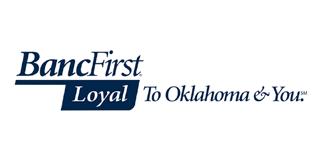



SPONSORS




LANE SPONSORS





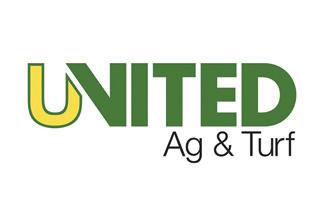



2510 Sam Noble Parkway
